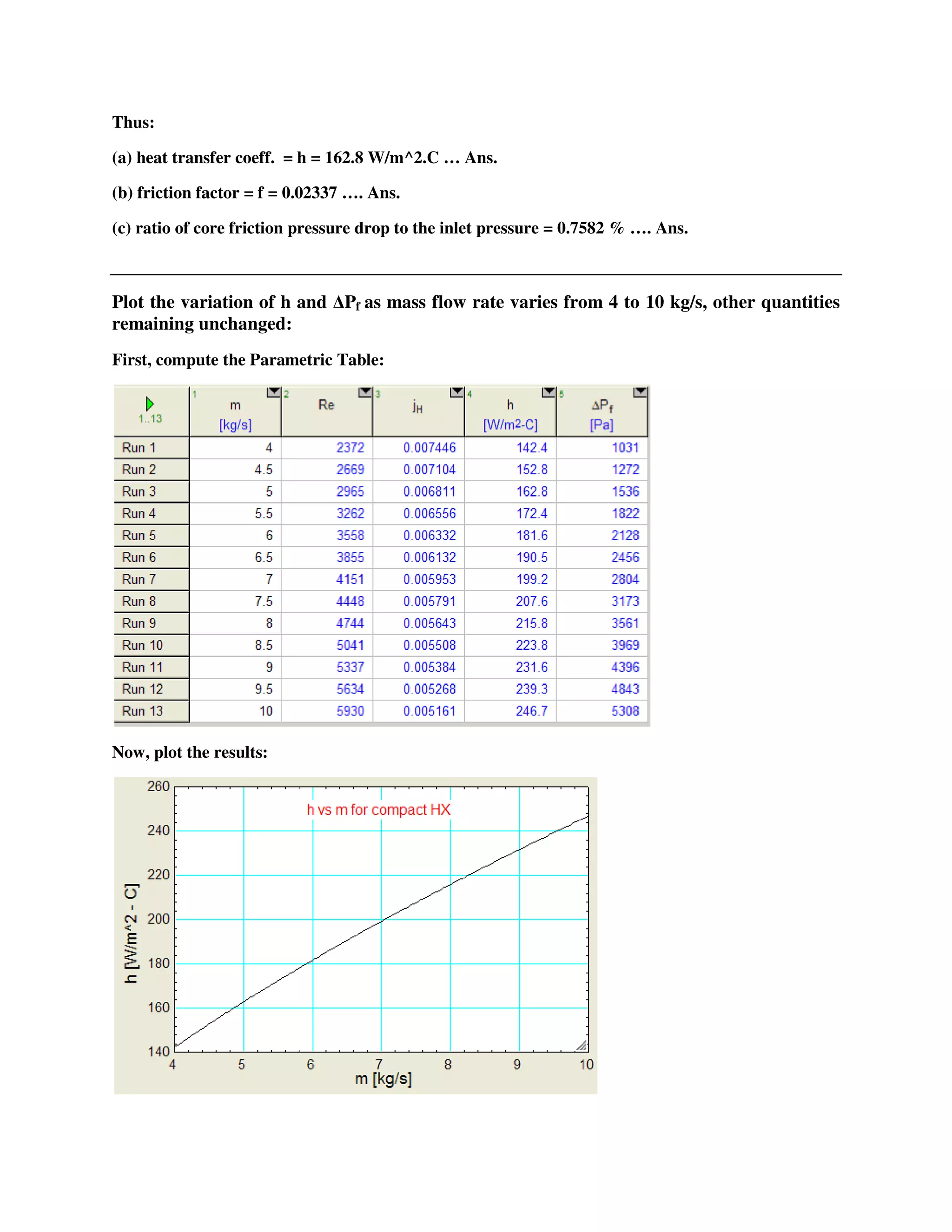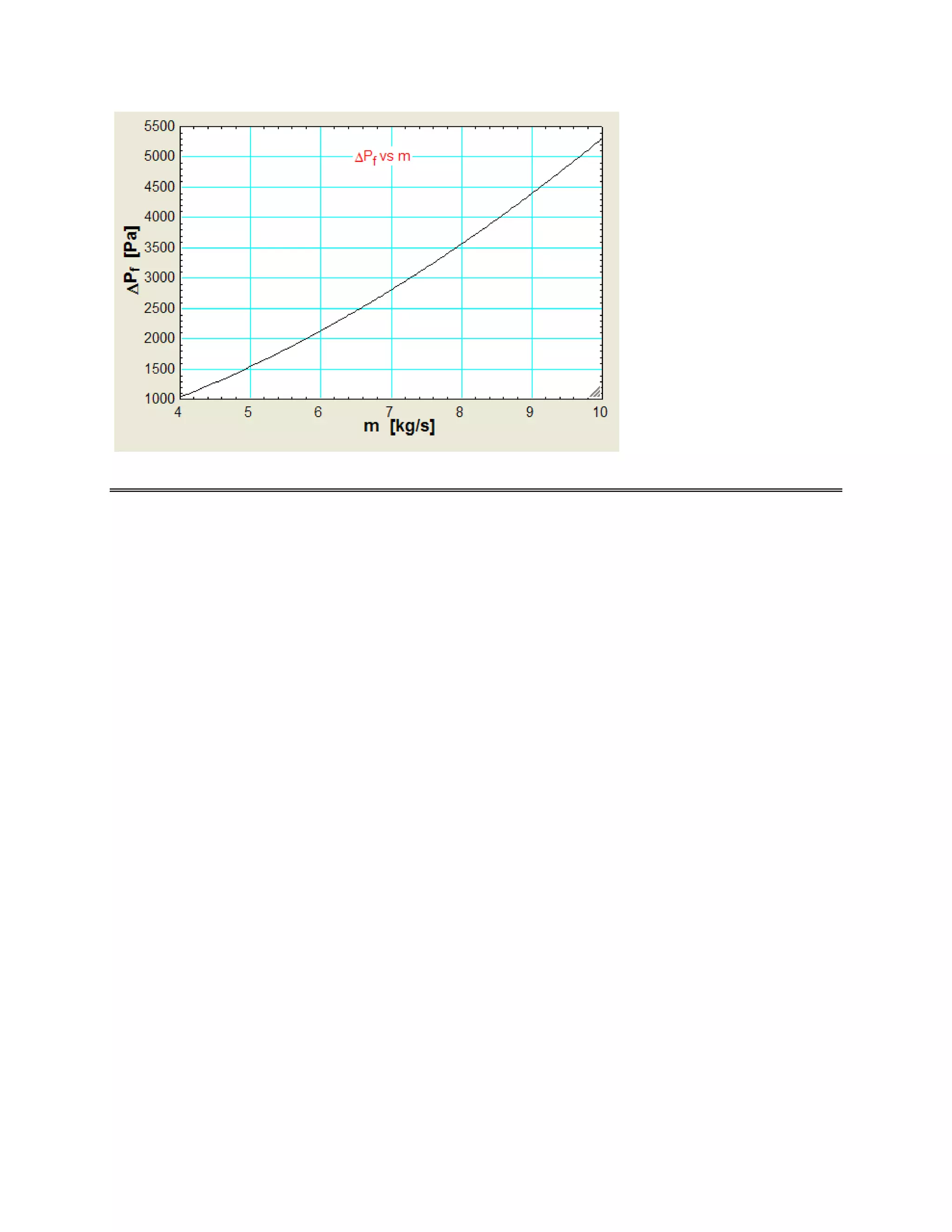The document discusses various heat transfer calculations, including procedures for determining overall heat transfer coefficients for plane walls and cylindrical walls, as well as methods for forced convection across cylinders. It includes example problems involving heat exchangers and their specific parameters such as dimensions, film coefficients, and fouling factors, with a focus on both inside and outside surfaces. The calculations incorporate inputs like fluid properties and temperature differences to find results such as exit temperatures and surface areas required for different heat exchanger configurations.
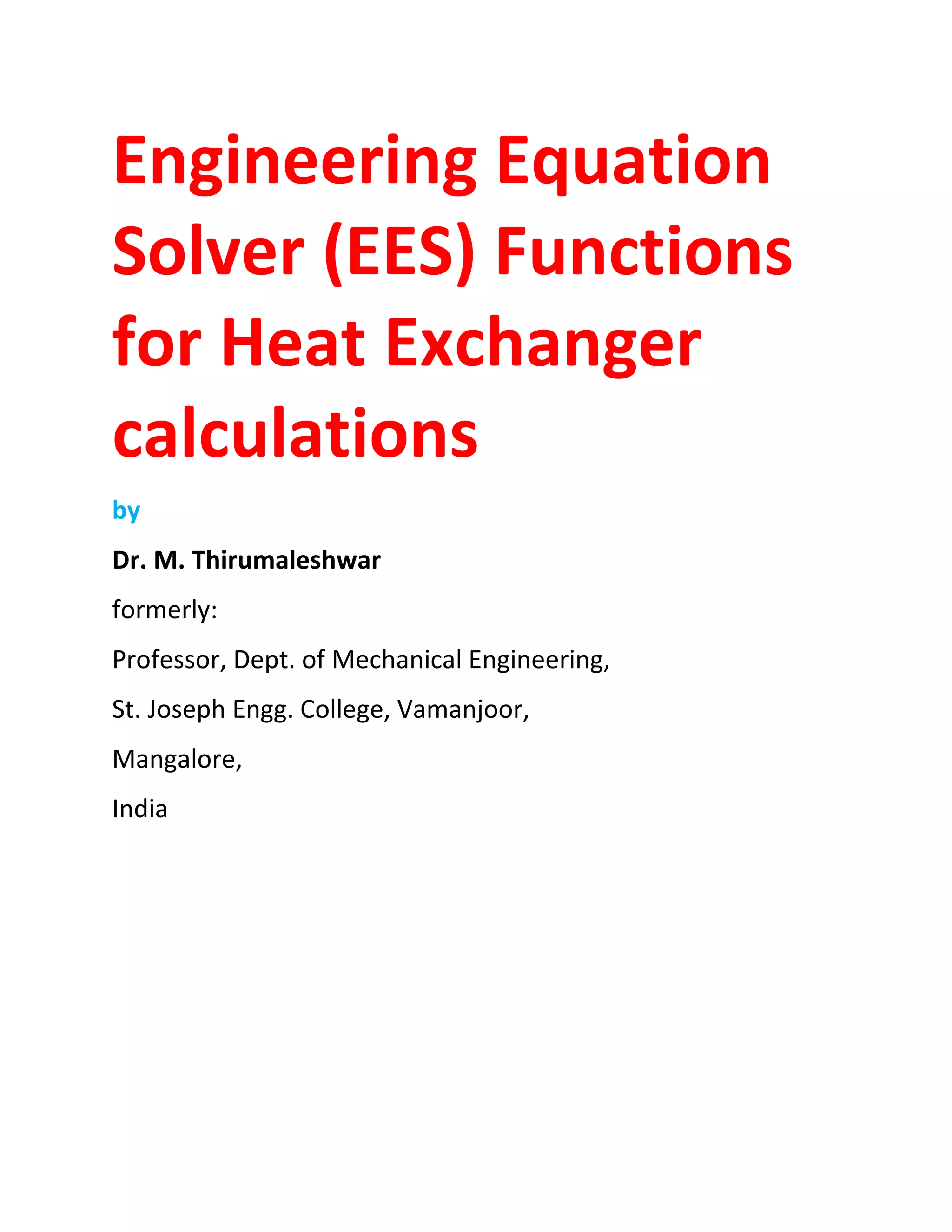
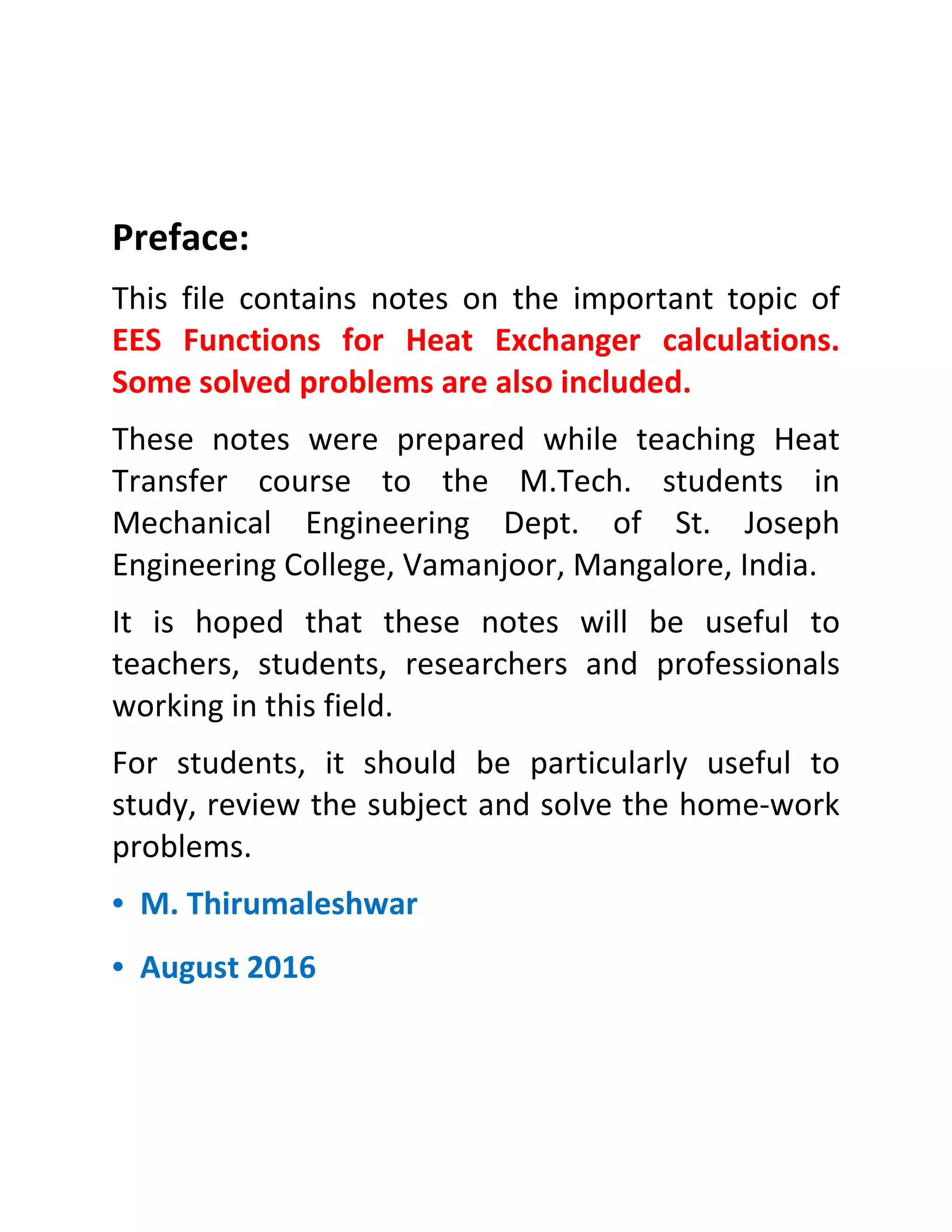
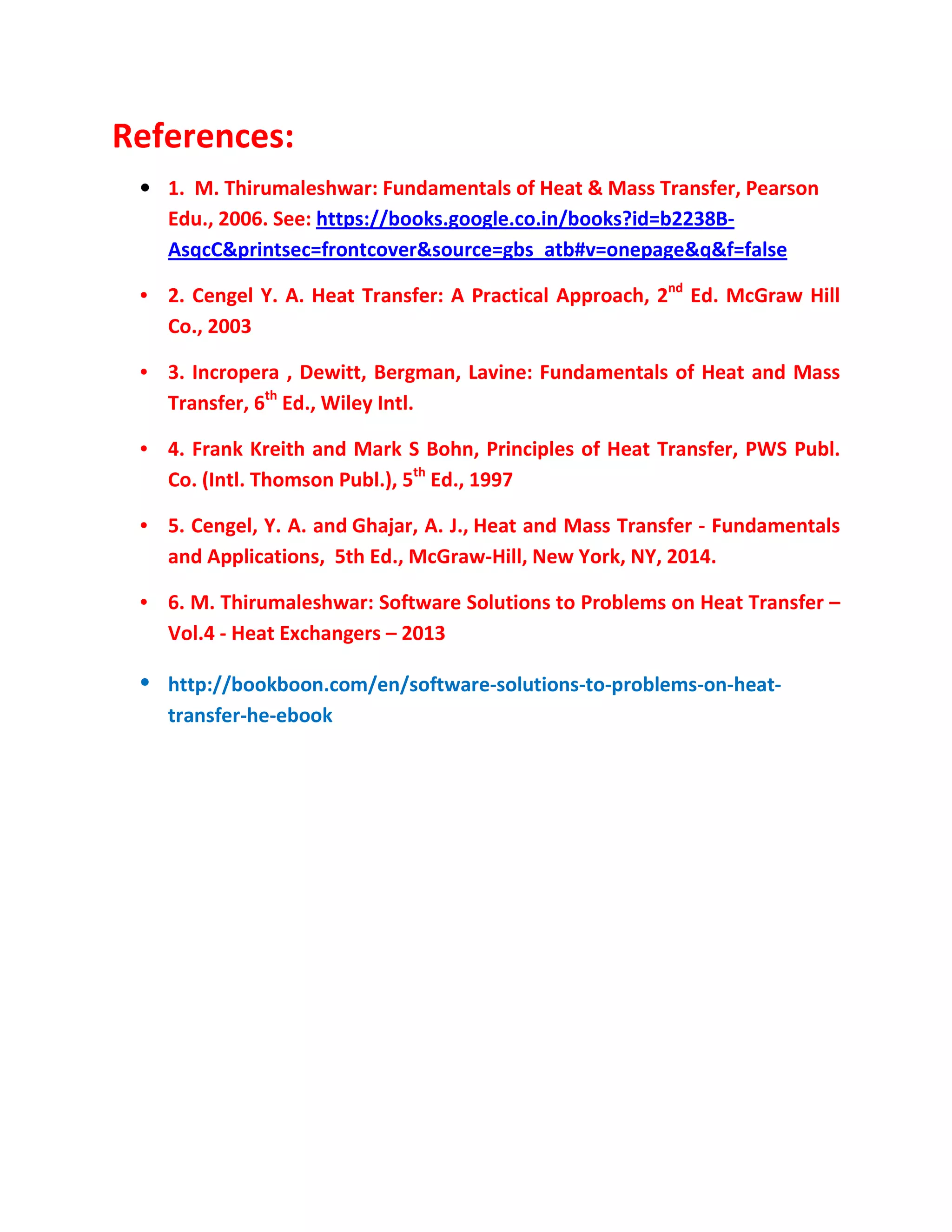
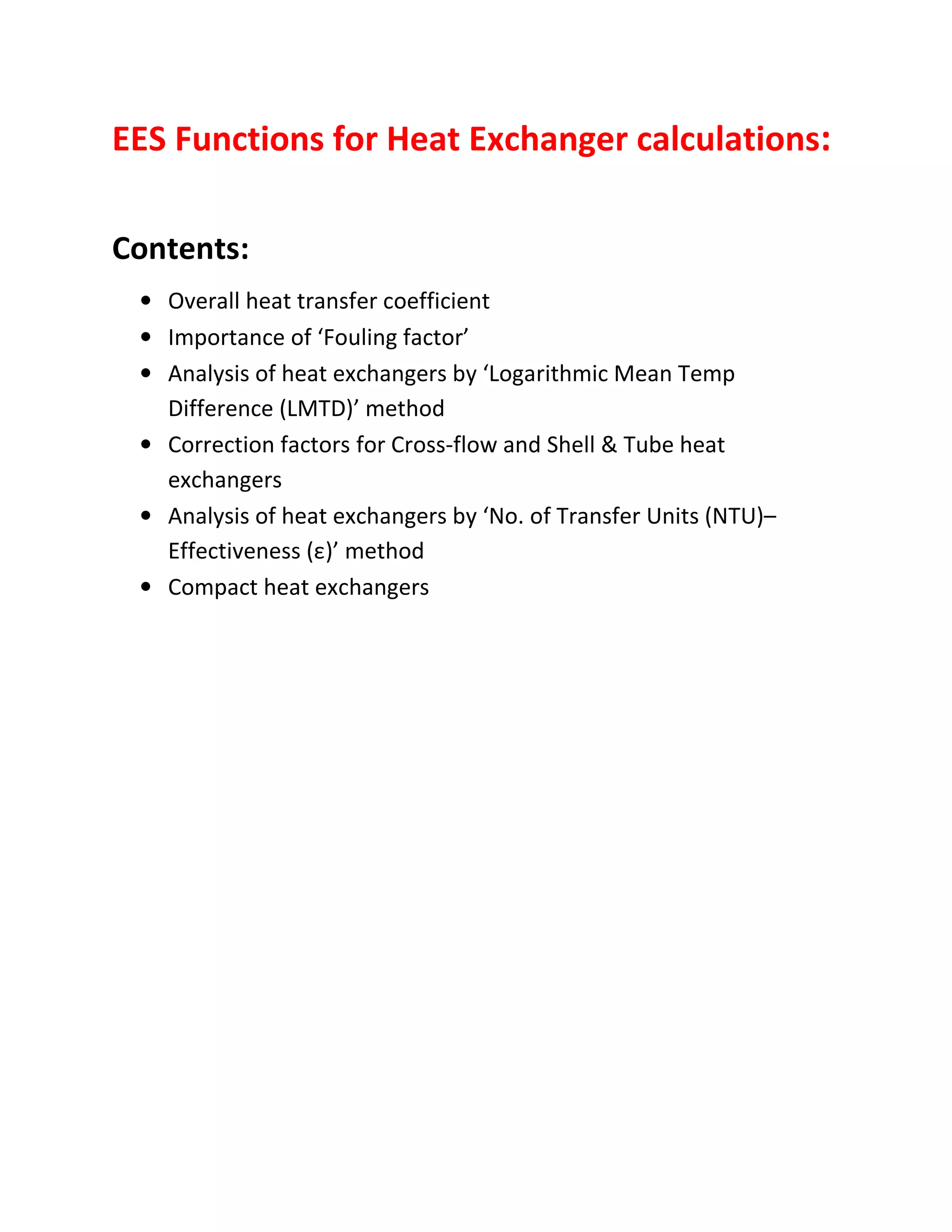
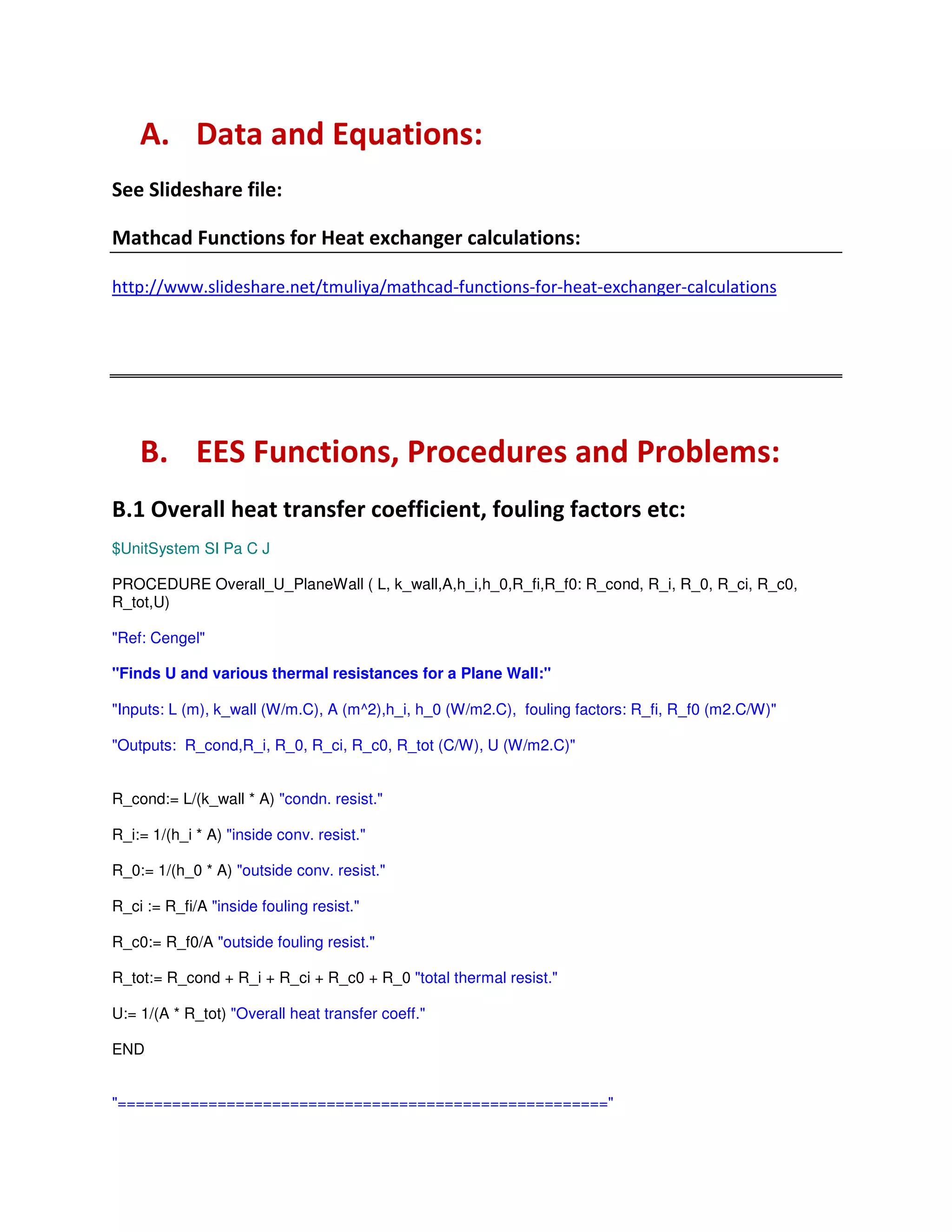
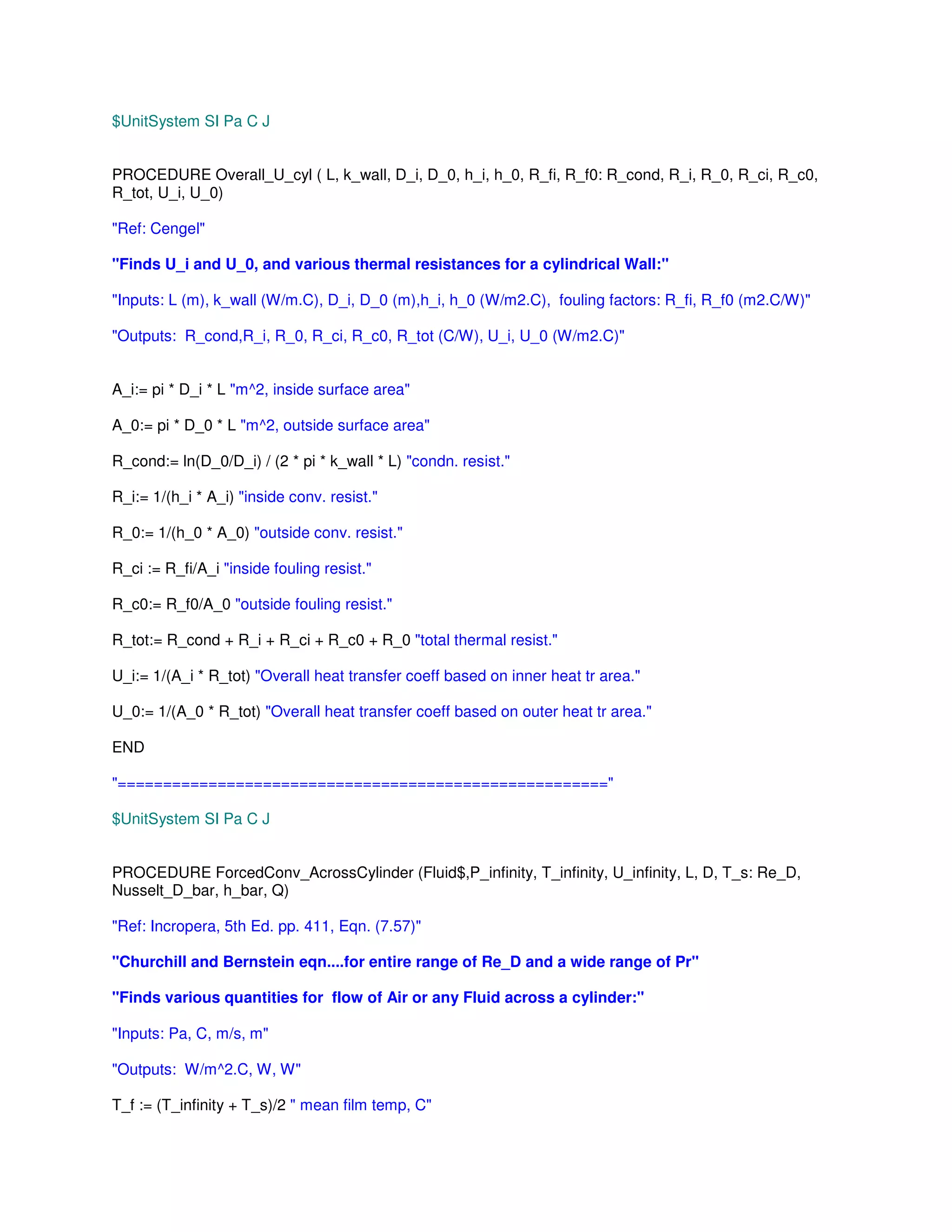
!["Properties of Air (Ideal gas) or other Fluid at T_f :"
IF Fluid$ = 'Air' Then
rho:=Density(Fluid$,T=T_f,P=P_infinity)
mu:=Viscosity(Fluid$,T=T_f)
k:=Conductivity(Fluid$,T=T_f)
Pr:=Prandtl(Fluid$,T=T_f)
cp:=SpecHeat(Fluid$,T=T_f)
ELSE
rho:=Density(Fluid$,T=T_f,P=P_infinity)
mu:=Viscosity(Fluid$,T=T_f,P=P_infinity)
k:=Conductivity(Fluid$,T=T_f,P=P_infinity)
Pr:=Prandtl(Fluid$,T=T_f,P=P_infinity)
cp:=SpecHeat(Fluid$,T=T_f,P=P_infinity)
ENDIF
Re_D := D * U_infinity * rho/mu "Finds Reynolds No."
"To find h accurately: Use Churchill and Bernstein eqn."
Nusselt_D_bar := 0.3 + ((0.62 * Re_D^0.5 * (Pr)^(1/3))/(1 + (0.4/Pr)^(2/3))^(1/4)) * (1 +
(Re_D/282000)^(5/8))^(4/5)
h_bar :=Nusselt_D_bar * k / D "Finds h_bar"
Q := h_bar * (pi * D * L) * (T_s - T_infinity) "W.... heat tr"
END
"======================================================================"
"Prob. B.1.1: A shell and tube counter-flow heat exchanger uses copper tubes (k = 380 W/(m.C)), 20 mm
ID and 23 mm OD. Inside and outside film coefficients are 5000 and 1500 W/(m2.C) respectively.
Fouling factors on the inside and outside may be taken as 0.0004 and 0.001 m2.C/W respectively.
Calculate the overall heat transfer coefficient based on: (i) outside surface, and (ii) inside surface."
"Data:"
D_i = 0.02 [m]
D_0 = 0.023 [m]
L = 1 [m]
k_wall = 380 [W/m_C]
h_i = 5000 [W/m^2-C] "...heat tr coeff on the inside"
h_0 = 1500 [W/m^2-C] "...heat tr coeff on the outside"
R_fi = 0.0004 [m^2-C/W] "...Fouling factor on the inside"](https://image.slidesharecdn.com/eesfunctionsforheatexchangercalculations-161030143052/75/EES-Procedures-and-Functions-for-Heat-exchanger-calculations-7-2048.jpg)
![R_f0 = 0.001 [m^2-C/W] "...Fouling factor on the outside"
"Calculations:"
CALL Overall_U_cyl ( L, k_wall, D_i, D_0, h_i, h_0, R_fi, R_f0: R_cond, R_i, R_0, R_ci, R_c0, R_tot,U_i,
U_0)
"======================================================================="
* "
"
H6 0 =2A ( < - I& 5 J %
H6' 0 =&1 ) < - I& 5J %
% , $ *6 # H6' . &' ='' < - 5"
, $ ! "](https://image.slidesharecdn.com/eesfunctionsforheatexchangercalculations-161030143052/75/EES-Procedures-and-Functions-for-Heat-exchanger-calculations-8-2048.jpg)
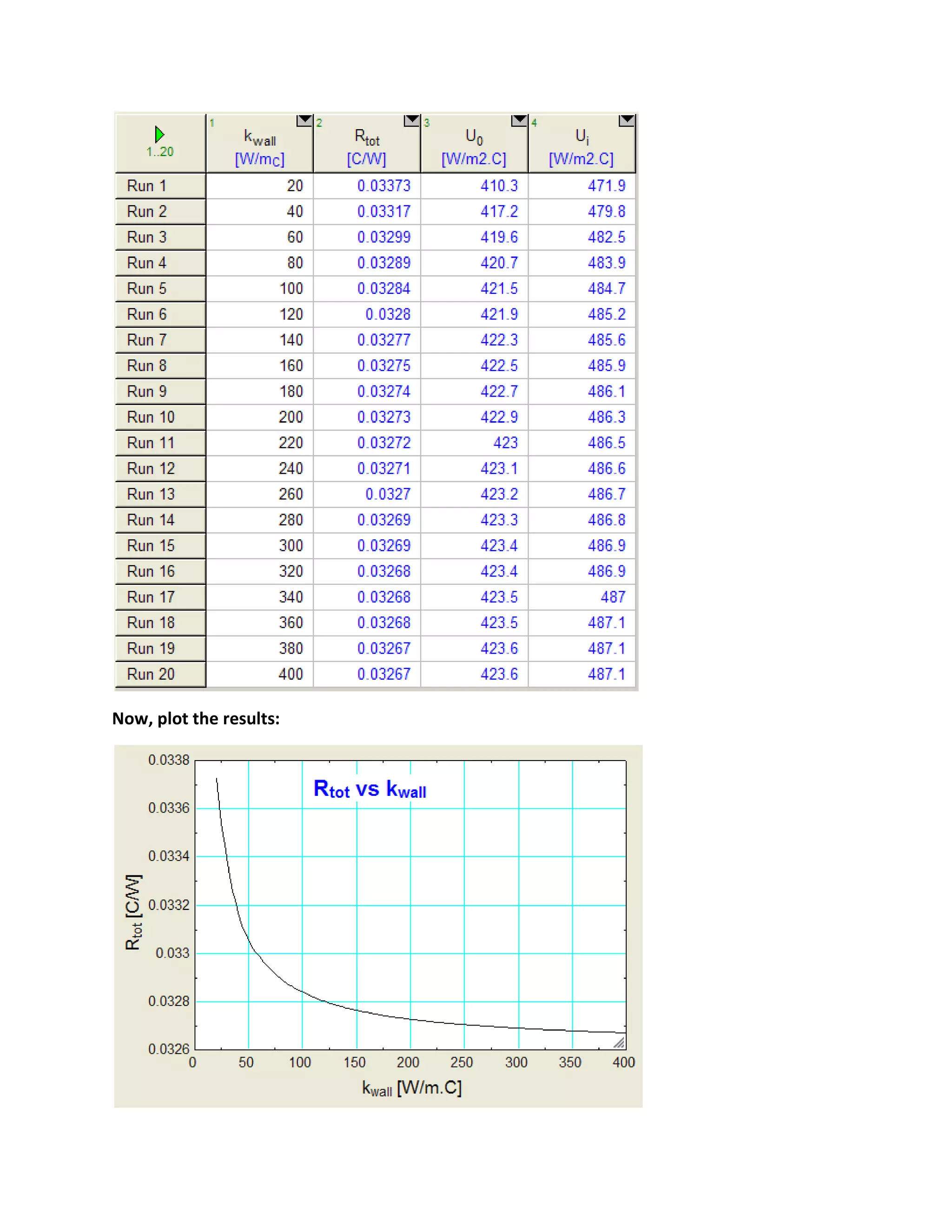
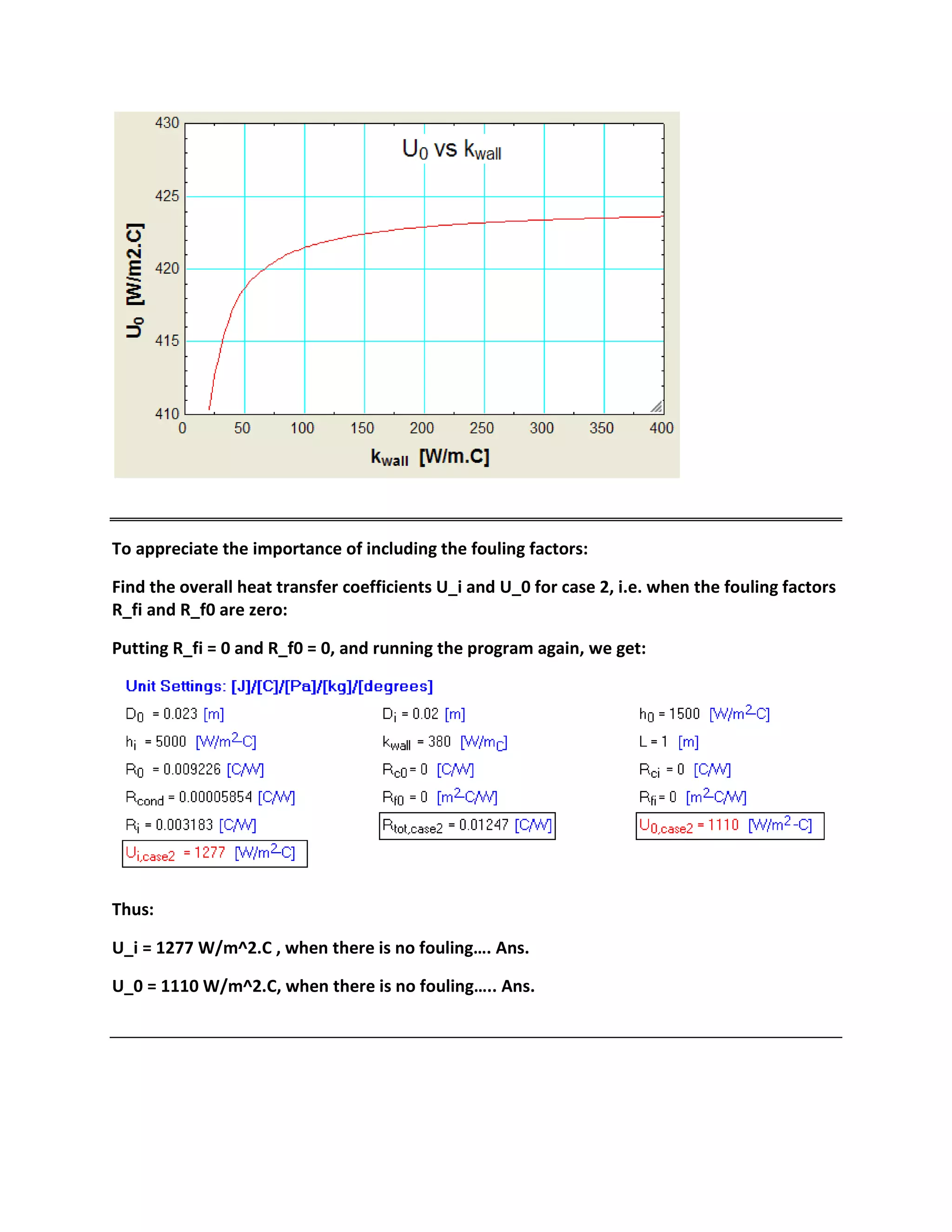
!["Prob. B.1.2: Consider a type 302 SS tube (k = 15.10 W/(m.C)), 22 mm ID and 27 mm OD, inside
which water flows at a mean temp T_m = 75 C and velocity u_m = 0.5 m/s. Air at 15 C and at a velocity
of V_0 = 20 m/s flows across this tube. Fouling factors on the inside and outside may be taken as 0.0004
and 0.0002 m^2.C/W respectively. Determine the overall heat transfer coefficient based on the outside
surface, U_0 (b) Plot U_o as a function of cross flow velocity, V_0 in the range: 5 < V_o < 30 m/s."
"EES Solution:"
"Data:"
D_i = 0.022 [m]
D_0 = 0.027 [m]
L = 1 [m]
k_wall = 15.1 [W/m-C]
T_m_water = 75 [C]
U_m_water = 0.5 [m/s]
P_1 = 1.01325E05 [Pa]
T_m_air = 15 [C]
V_0_air = 20 [m/s]
"Properties of Water at T_m:"
rho_w=Density(Steam_IAPWS,T=T_m_water,P=P_1)
mu_w=Viscosity(Steam_IAPWS,T=T_m_water,P=P_1)
cp_w=SpecHeat(Steam_IAPWS,T=T_m_water,P=P_1)
k_w=Conductivity(Steam_IAPWS,T=T_m_water,P=P_1)
Pr_w=Prandtl(Steam_IAPWS,T=T_m_water,P=P_1)
"Calculations:"
"To determine inside heat transfer coeff. h_i:"
Re_water = D_i * U_m_water * rho_w / mu_w "...finds Reynolds No. for water"
"Re_water = 28388 > 4000; So, apply Dittus - Boelter eqn to find out Nusselts No.:"
Nusselts_w = 0.023 * Re_water^0.8 * Pr_w^0.4 "...gives Nusselts No."
Nusselts_w = h_i * D_i /k_w "....finds h_i, heat tr coeff on the inside "
"To determine outside heat transfer coeff. h_0:"
"It is cross flow of air across a cylinder. So, use the EES PROCEDURE written above to find out h_0,
using the Churchill - Bernstein eqn for cross flow of a fluid over a cylinder:"](https://image.slidesharecdn.com/eesfunctionsforheatexchangercalculations-161030143052/75/EES-Procedures-and-Functions-for-Heat-exchanger-calculations-11-2048.jpg)
![Fluid$ = 'Air'
P_infinity = P_1
T_infinity = 15[C]
U_infinity = V_0_air
D = D_0
{T_s = 70 "[C] .... assumed, will be corrected later"}
CALL ForcedConv_AcrossCylinder (Fluid$,P_infinity, T_infinity, U_infinity, L, D, T_s: Re_D,
Nusselt_D_bar, h_0, Q)
R_fi = 0.0004 [m^2-C/W] "...Fouling factor on the inside"
R_f0 = 0.0002 [m^2-C/W] "...Fouling factor on the outside"
CALL Overall_U_cyl ( L, k_wall, D_i, D_0, h_i, h_0, R_fi, R_f0: R_cond, R_i, R_0, R_ci, R_c0, R_tot, U_i,
U_0)
{(T_s - T_m_air) / R_conv_out = (T_m_water - T_s) / (R_conv_in + R_c_in + R_cond_wall + R_c_out)
"....finds T_s, the surface temp of cylinder"}
(T_s - 15[C]) / R_0 = (T_m_water - T_s) / (R_i +R_ci + R_cond + R_c0) "Finds surface temp on the
fouling layer on the outer surface of the tube "
U_i * A_i = 1 / R_tot "...determine U _i"
U_0 * A_0 = 1 / R_tot "...determine U _0"
Results:](https://image.slidesharecdn.com/eesfunctionsforheatexchangercalculations-161030143052/75/EES-Procedures-and-Functions-for-Heat-exchanger-calculations-12-2048.jpg)
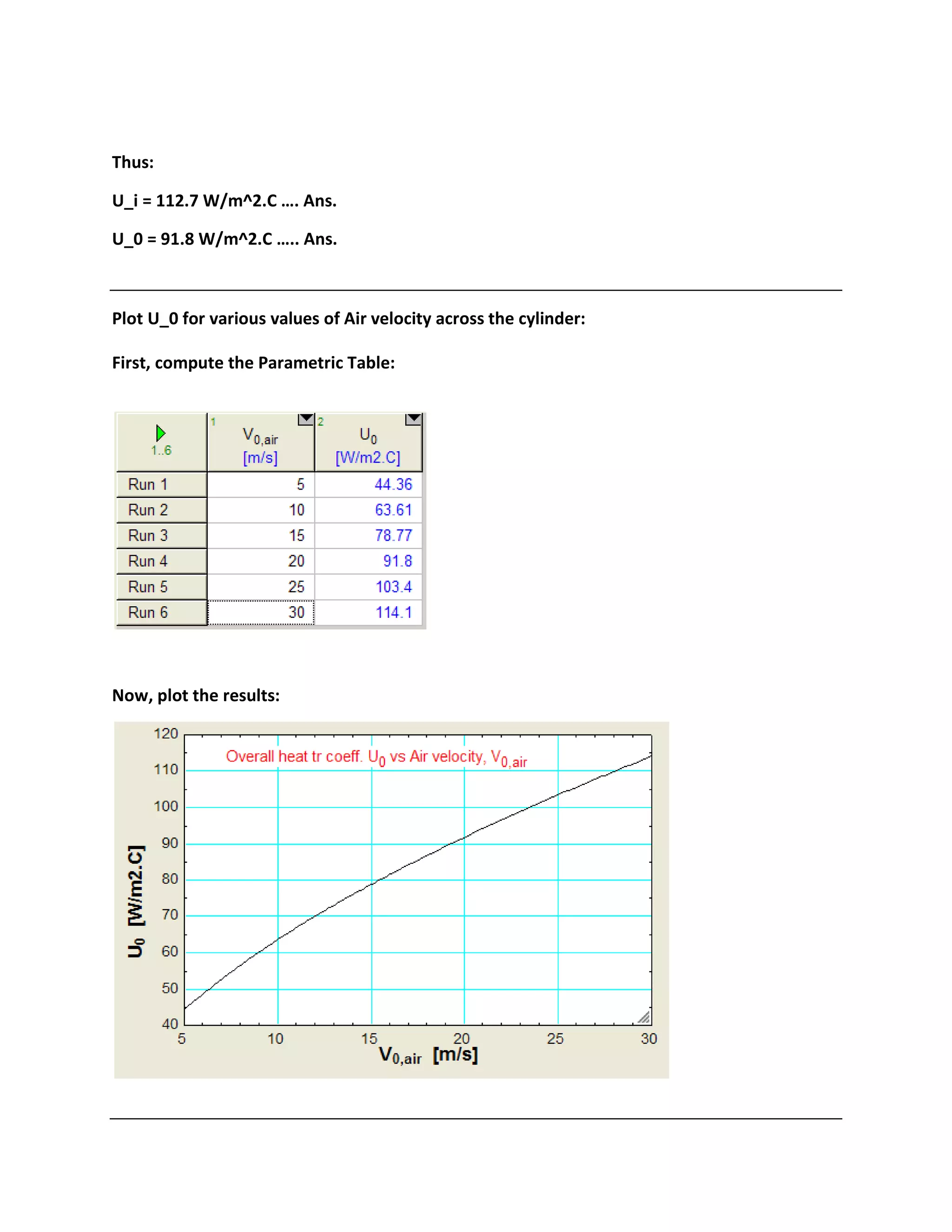
![3 & ; # # , ; 5
"Prob. B.2.1. A HX is required to cool 55000 kg/h of alcohol from 66 C to 40 C using 40000 kg/h of
water entering at 5 C. Calculate the following: (i) the exit temp of water (ii) surface area required for
parallel flow and counter-flow HXs. Take U = 580 W/m^2.K, cp for alcohol = 3760 J/kg.K, cp for water
= 4180 J/kg.K. [VTU -May - June- 2006]"
Fig. Prob.B.2.1(a).Counter-flow arrangement
Fig. Prob.B.2.1(b).Parallel flow arrangement
EES Solution:
"Data:"
m_h = 55000 [kg/h] * convert (kg/h, kg/s) "...hot fluid---alcohol"
m_c = 40000 [kg/h] * convert (kg/h, kg/s) "....cold fluid -- water"
T_h_i = 66 [C]
T_c_i = 5 [C]
T_h_o = 40 [C]
cp_h = 3760 [J/kg-C]](https://image.slidesharecdn.com/eesfunctionsforheatexchangercalculations-161030143052/75/EES-Procedures-and-Functions-for-Heat-exchanger-calculations-14-2048.jpg)
![cp_c = 4180 [J/kg-C]
U= 580 [W/m^2-C]
"Calculations:"
"Exit temp of cold fluid:"
m_h * cp_h * (T_h_i - T_h_o) = m_c * cp_c * (T_c_o - T_c_i) " C...determines T_c_o"
"LMTD for a counter-flow HX:"
DELTAT_1 = T_h_i - T_c_o " Temp diff at inlet of HX --- for counter flow HX"
DELTAT_2 = T_h_o - T_c_i " Temp diff at exit of HX --- for counter flow HX"
LMTD_cflow = (DELTAT_1 - DELTAT_2)/ln(DELTAT_1/DELTAT_2) "C...determines LMTD"
Q = m_h * cp_h * (T_h_i - T_h_o) "W...heat tr."
Q = U * A_cflow * LMTD_cflow "Finds A_cflow for counter-flow HX"
"LMTD for a parallel flow HX:"
DT_1 = T_h_i - T_c_i " Temp diff at inlet of HX --- for parallel flow HX"
DT_2 = T_h_o - T_c_o " Temp diff at exit of HX --- for parallel flow HX"
LMTD_pflow = (DT_1 - DT_2)/ln(DT_1/DT_2) "C...determines LMTD"
Q = U * A_pflow * LMTD_pflow "Finds A_pflow for parallel-flow HX"
Results:
Thus:
Exit temp of water = 37.16 C … Ans.
Area for parallel flow HX = 135.8 m^2 …. Ans.
Area for counter-flow HX = 80.92 m^2 …. Ans.
--------------------------------------------------------------------------------------------------------------](https://image.slidesharecdn.com/eesfunctionsforheatexchangercalculations-161030143052/75/EES-Procedures-and-Functions-for-Heat-exchanger-calculations-15-2048.jpg)
![Prob. B.2.2. Sat. steam at 120 C is condensing on the outer surface of a single pass HX. The overall heat
transfer coeff is 1600 W/m^2.C. Determine the surface area of the HX required to heat 2000 kg/h of water
from 20 C to 90 C. Also determine the rate of condensation of steam (kg/h). Assume latent heat of steam
as 2195 kJ/kg. [VTU-Aug. 2001]
Fig. Prob.B.2.2.
EES Solution:
"Data:"
m_c = 2000 [kg/h] * convert (kg/h, kg/s) "....cold fluid -- water"
T_h = 120 [C]
T_c_i = 20 [C]
T_c_o = 90 [C]
cp_c = 4180 [J/kg-C]
U= 1600 [W/m^2-C]
"LMTD for a condenser:"
DELTAT_1 = T_h - T_c_i " Temp diff at inlet "
DELTAT_2 = T_h - T_c_o " Temp diff at exit "
LMTD = (DELTAT_1 - DELTAT_2)/ln(DELTAT_1/DELTAT_2) "C...determines LMTD"
Q = m_c * cp_c * (T_c_o - T_c_i) "W....finds heat tr, Q"
Q = U * A * LMTD "Finds Area, A for condenser"
h_fg = 2195000 [J/kg] "...latent heat for steam condensing"
m_h * h_fg = Q " kg/s...determines mass of steam condensed"
m_steam_perhour = m_h * convert (kg/s, kg/h)
Results:](https://image.slidesharecdn.com/eesfunctionsforheatexchangercalculations-161030143052/75/EES-Procedures-and-Functions-for-Heat-exchanger-calculations-16-2048.jpg)
![Thus:
Area of HX = A = 1.747 m^2 …. Ans.
Rate of condensation of steam = 266.6 kg/h … Ans.
"Prob. B.2.3. A simple HX consisting of two concentric passages is used for heating 1110 kg/h of oil (cp
= 2.1 kJ/kg.K) from 27 C to 49 C. The oil flows through the inner pipe made of copper (OD = 2.86 cm,
ID = 2.54 cm, k = 350 W/m.K) and the surface heat transfer coeff on the oil side is 635 W/m^2.K. The oil
is heated by hot water supplied at a rate of 390 kg/h with an inlet temp of 93 C. The water side heat
transfer coeff. is 1270 W/m^2.K. The fouling factors on the oil and water sides are 0.0001 and 0.0004
m^2.K/W respectively. What is the length of HX required for (i) parallel flow, and
(ii) counter-flow ? [VTU-Jan-Feb.- 2006]"
Fig. Prob.B.2.3(a)..Counter-flow arrangement
Fig. Prob.B.2.3(b)..Parallel flow arrangement](https://image.slidesharecdn.com/eesfunctionsforheatexchangercalculations-161030143052/75/EES-Procedures-and-Functions-for-Heat-exchanger-calculations-17-2048.jpg)
![EES Solution:
"Data:"
m_h = 390 [kg/h] * convert (kg/h, kg/s) "...hot fluid---water"
m_c = 1110 [kg/h] * convert (kg/h, kg/s) "....cold fluid -- oil - flows through inner pipe"
T_h_i = 93 [C]"...inlet temp of hoy fluid"
T_c_i = 27 [C]"...inlet temp of cold fluid"
T_c_0 = 49[C] "...outlet temp of cold fluid"
cp_h = 4180 [J/kg-C]
cp_c = 2100 [J/kg-C]
h_h = 1270[W/m^2-C]
h_c = 635[W/m^2-C]
d_i = 0.0254[m]
d_0 = 0.0286[m]
k_wall = 350 [W/m-C]
R_fi = 0.0001[m^2-C/W]
R_f0 = 0.0004[m^2-C/W]
L = 1[m]"...assumed"
A_i = pi * d_i * L "[m^2]....inside surface area"
A_0 = pi * d_0 * L "[m^2]....outside surface area"
"Calculations:"
"Overall heat tr coeff."
CALL Overall_U_cyl ( L, k_wall, d_i, d_0, h_c, h_h, R_fi, R_f0: R_cond, R_i, R_0, R_ci, R_c0, R_tot, U_i,
U_0) "..here, we get U_i and U_0 "
Running the above program, we get U_i:
i.e. U_i = 365.8 W/m^2.C .. Ans.
Continuing the program:
m_h * cp_h * (T_h_i - T_h_o) = m_c * cp_c * (T_c_o - T_c_i) " C...determines T_h_o"](https://image.slidesharecdn.com/eesfunctionsforheatexchangercalculations-161030143052/75/EES-Procedures-and-Functions-for-Heat-exchanger-calculations-18-2048.jpg)
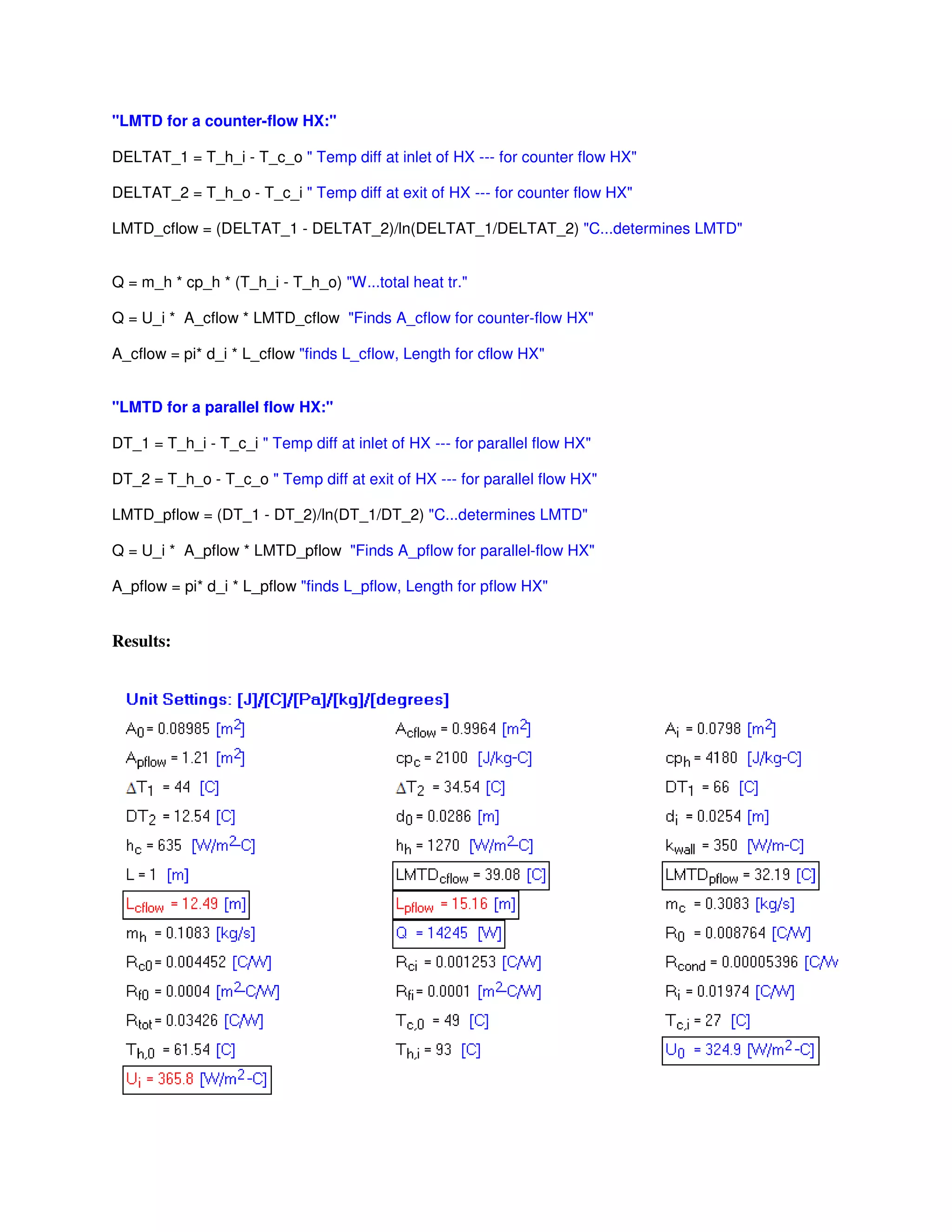
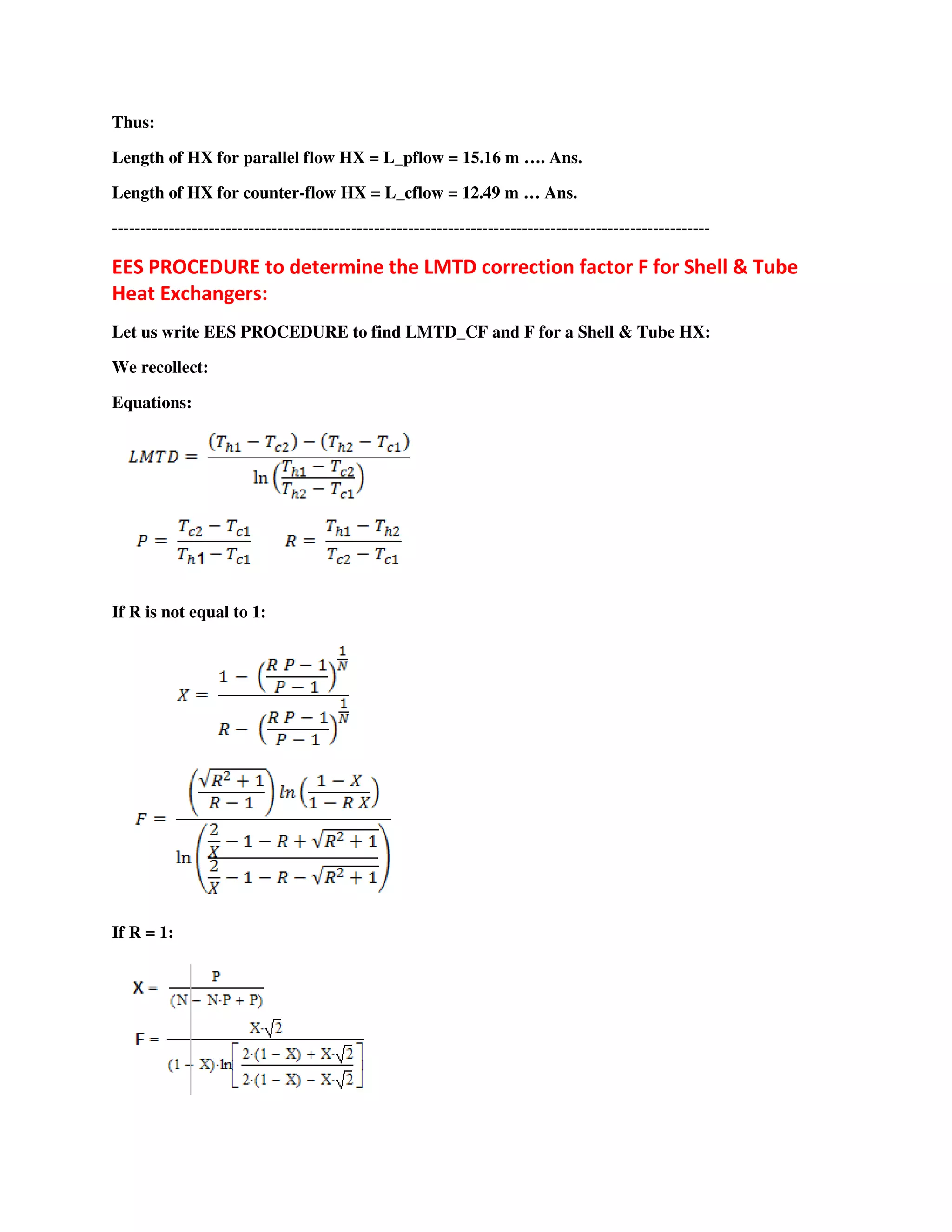
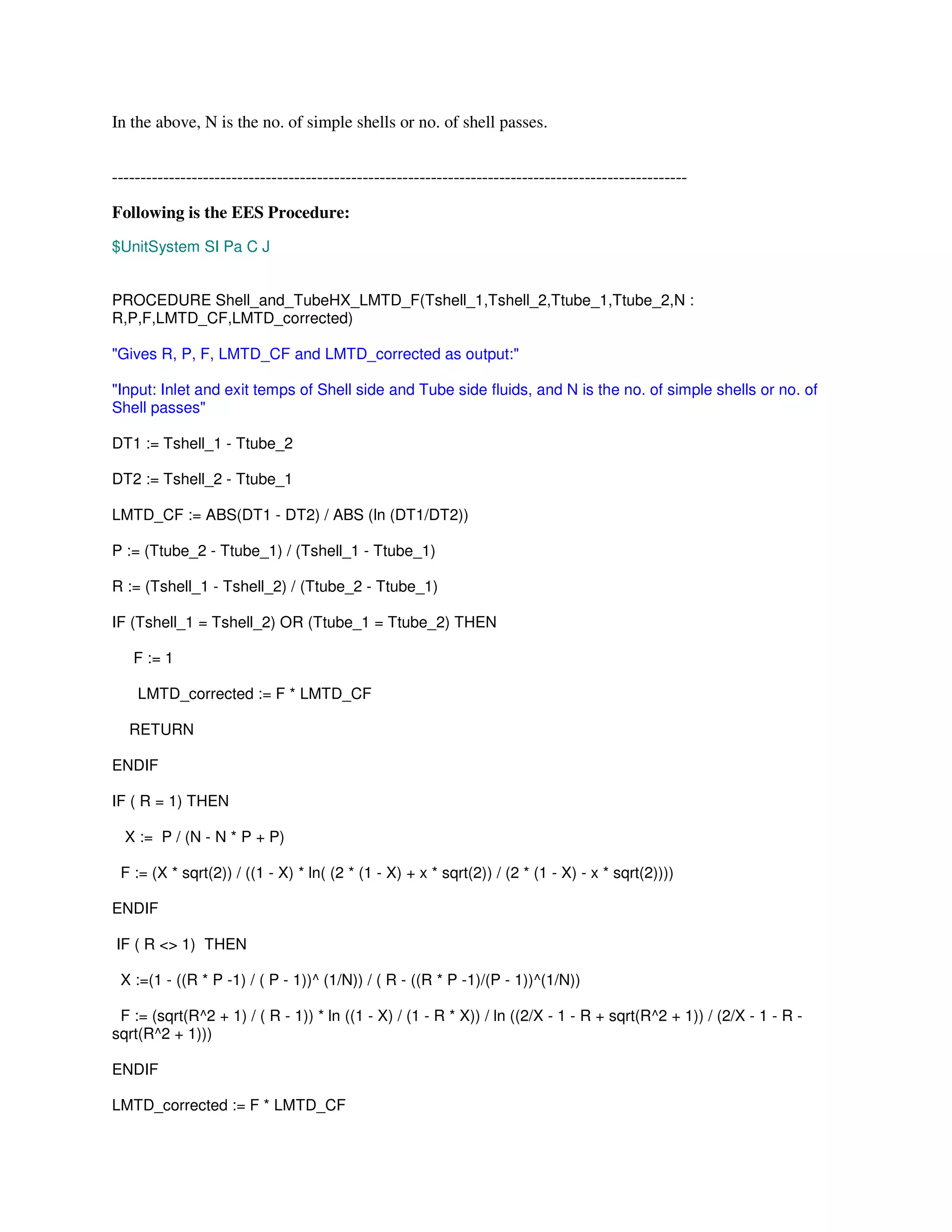
![END
"---------------------------------------------------------------------"
Let us use this PROCEDURE to solve the following problem:
Prob. B.2.4. In a Shell & Tube HX, water, making one Shell pass, at a rate of 1 kg/s is heated from 35 to
75 C by an oil of sp. heat 1900 J/kg.C. Oil flows at a rate of 2.5 kg/s through the tubes making 2 passes
and enters the Shell at 110 C. If the overall heat transfer coeff. U is 350 W/m^2.C, calculate the area
required."
Fig. Prob.B.2.4. Temp profile for Counter-flow arrangement
EES Solution:
"Data:"
Tshell_1 = 35[C]"....inlet temp of water"
Tshell_2 = 75 [C]"....exit temp of water"
Ttube_1 =110 [C]"....inlet temp of oil"
m_water = 1 [kg/s]
cp_water = 4180 [J/kg-C]
m_oil = 2.5 [kg/s]
cp_oil = 1900 [J/kg-C]
U = 350 [W/m^2-C]
N = 1
"Calculation:"
"Total heat transferred, Q:"
Q = m_water * cp_water * (Tshell_2 - Tshell_1) "[W]"
Q = m_oil * cp_oil * (Ttube_1 - Ttube_2)"[C]...finds exit temp of oil, Ttube_2"
"Also:"
Q = U * A * F * LMTD_CF "...where F is the LMTD correction factor, and LMTD_CF is the LMTD for a true
counter-flow HX"](https://image.slidesharecdn.com/eesfunctionsforheatexchangercalculations-161030143052/75/EES-Procedures-and-Functions-for-Heat-exchanger-calculations-22-2048.jpg)
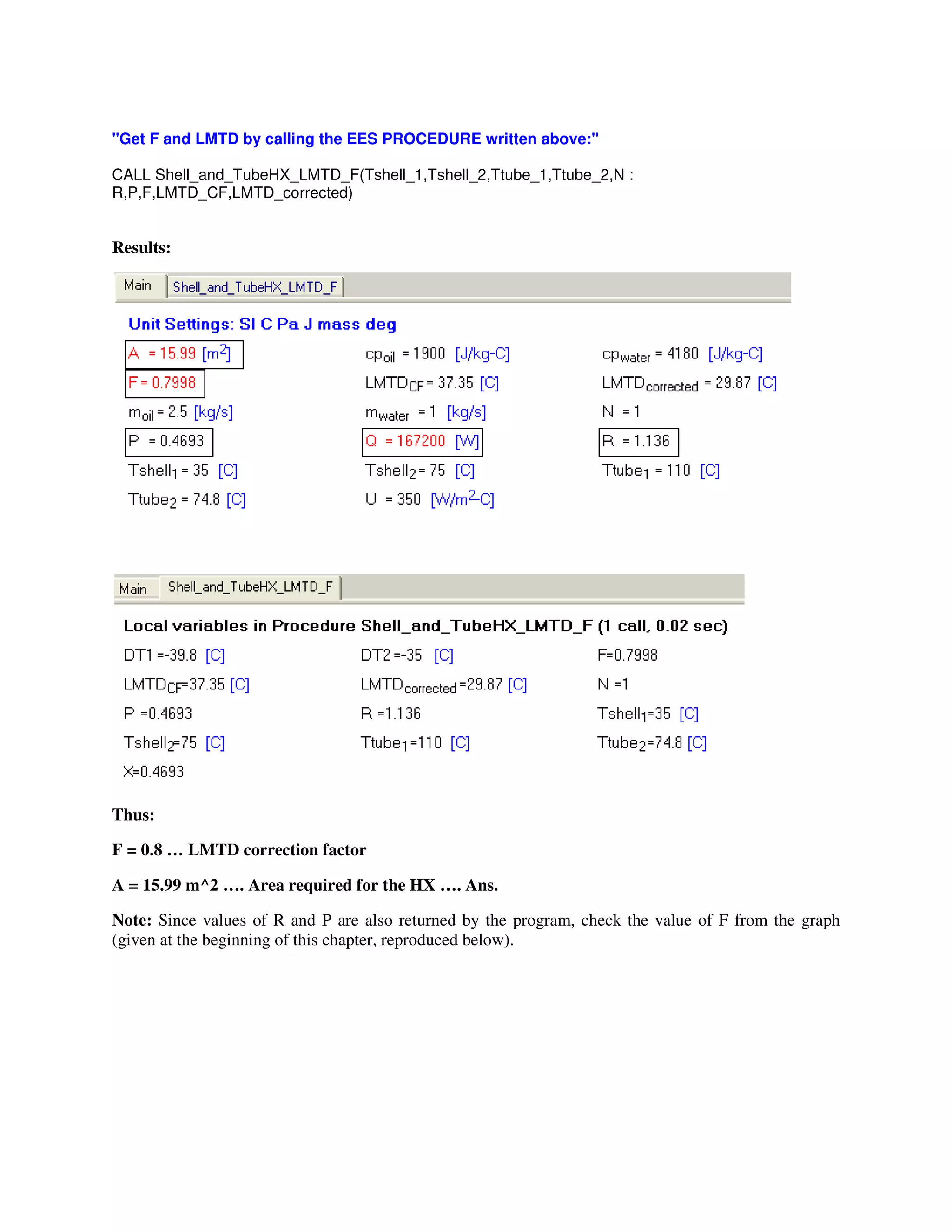
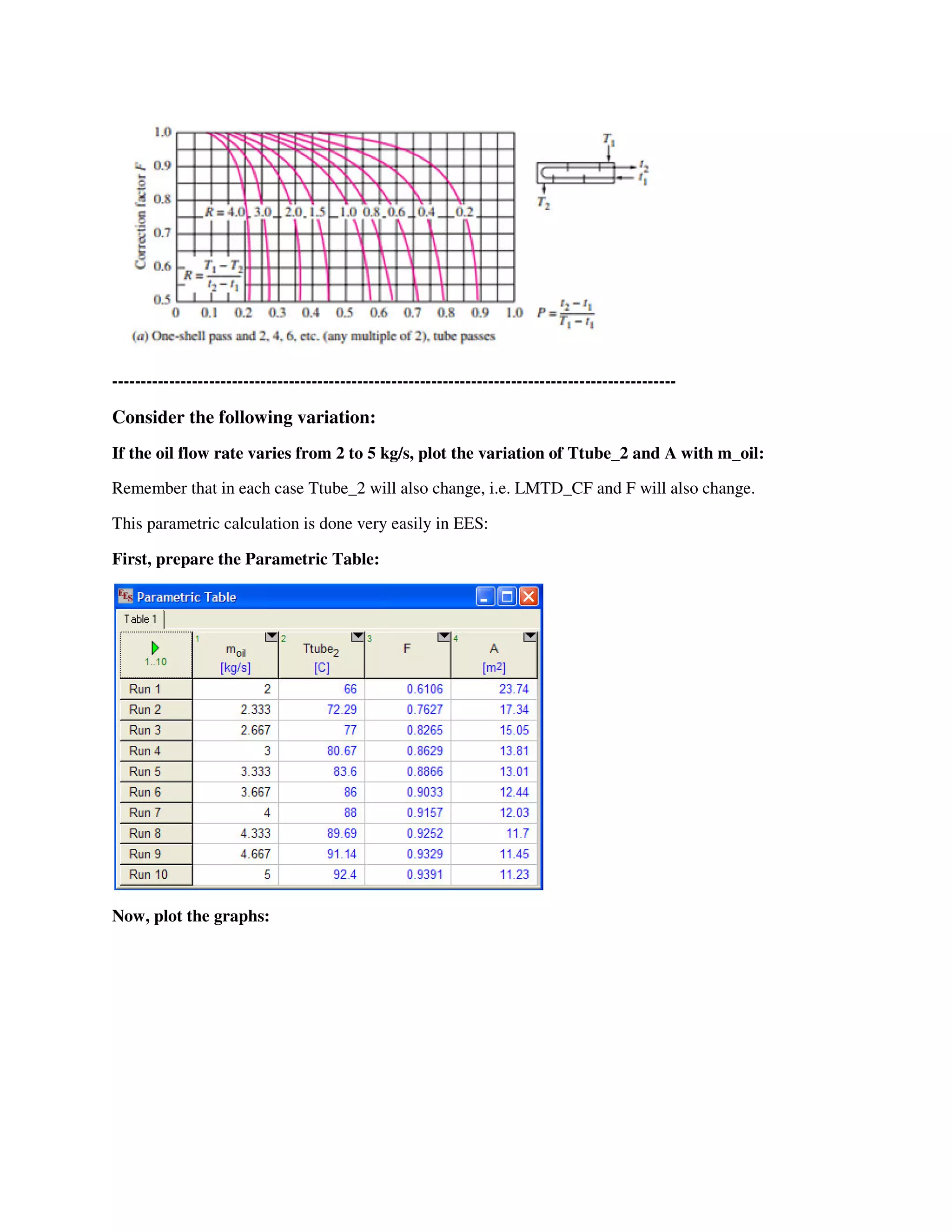
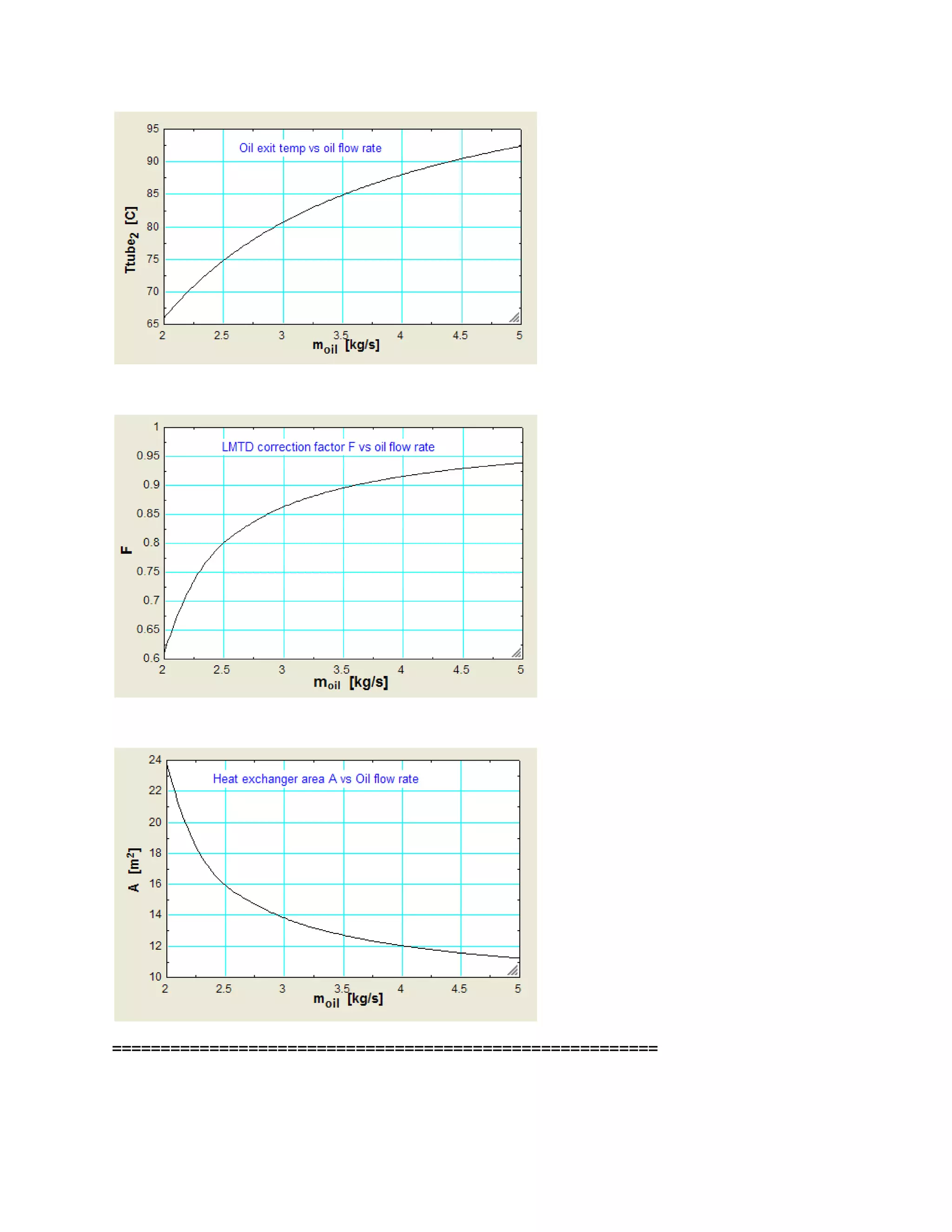
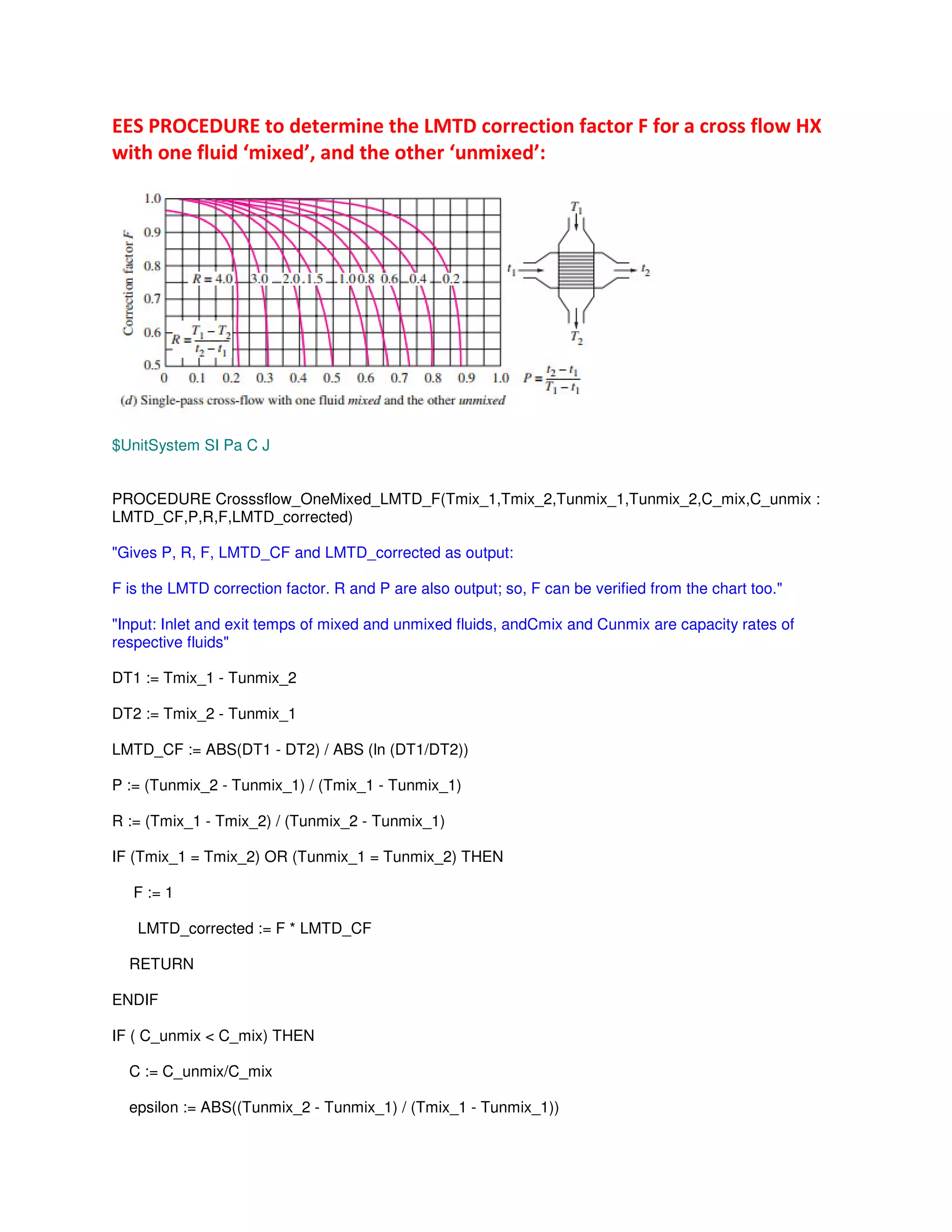
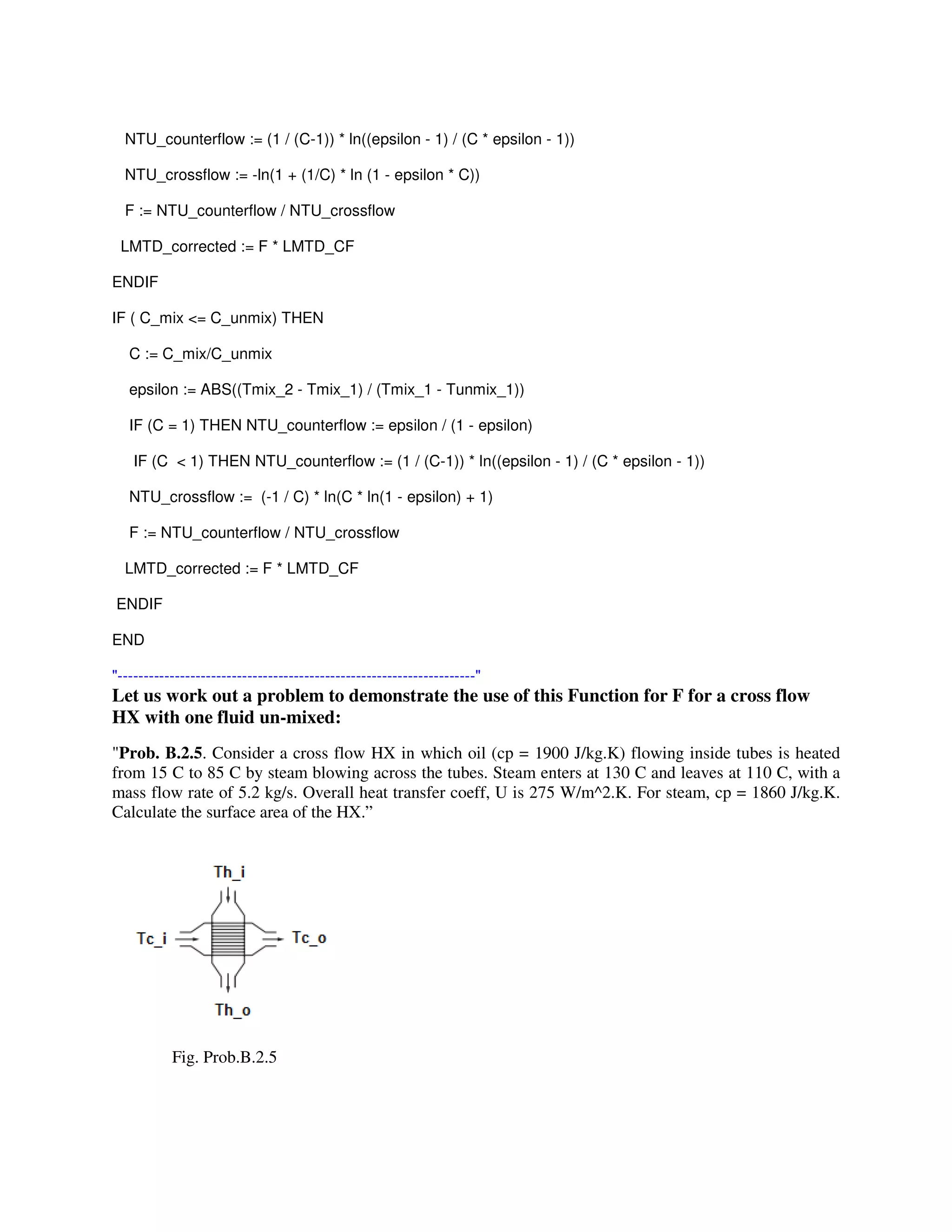
![EES Solution:
"Data:"
Tmix_1 = 130 [C]
Tmix_2 = 110 [C]
Tunmix_1 = 15 [C]
Tunmix_2 = 85 [C]
cp_oil = 1900 [J/kg-C]
cp_steam = 1860 [J/kg-C]
m_steam = 5.2 [kg/s]
U = 275 [W/m^2 - C]
"Calculations:"
C_mix = m_steam * cp_steam "W/C... capacity rate of mixed fluid, i.e. steam"
Q = C_mix * (Tmix_1 - Tmix_2) "W"
C_unmix = Q / (Tunmix_2 - Tunmix_1) "W/C ...capacity rate of un-mixed fluid, i.e. oil"
"Using the EES Procedure written earlier:"
CALL Crosssflow_OneMixed_LMTD_F(Tmix_1,Tmix_2,Tunmix_1,Tunmix_2,C_mix,C_unmix :
LMTD_CF,P,R,F,LMTD_corrected)
Results:
Thus:
LMTD correction factor, F = 0.9469
Area of HX, A = 11.1 m^2 …. Ans.
Note: Verify value of F from the graph given above.
=====================================================================](https://image.slidesharecdn.com/eesfunctionsforheatexchangercalculations-161030143052/75/EES-Procedures-and-Functions-for-Heat-exchanger-calculations-28-2048.jpg)
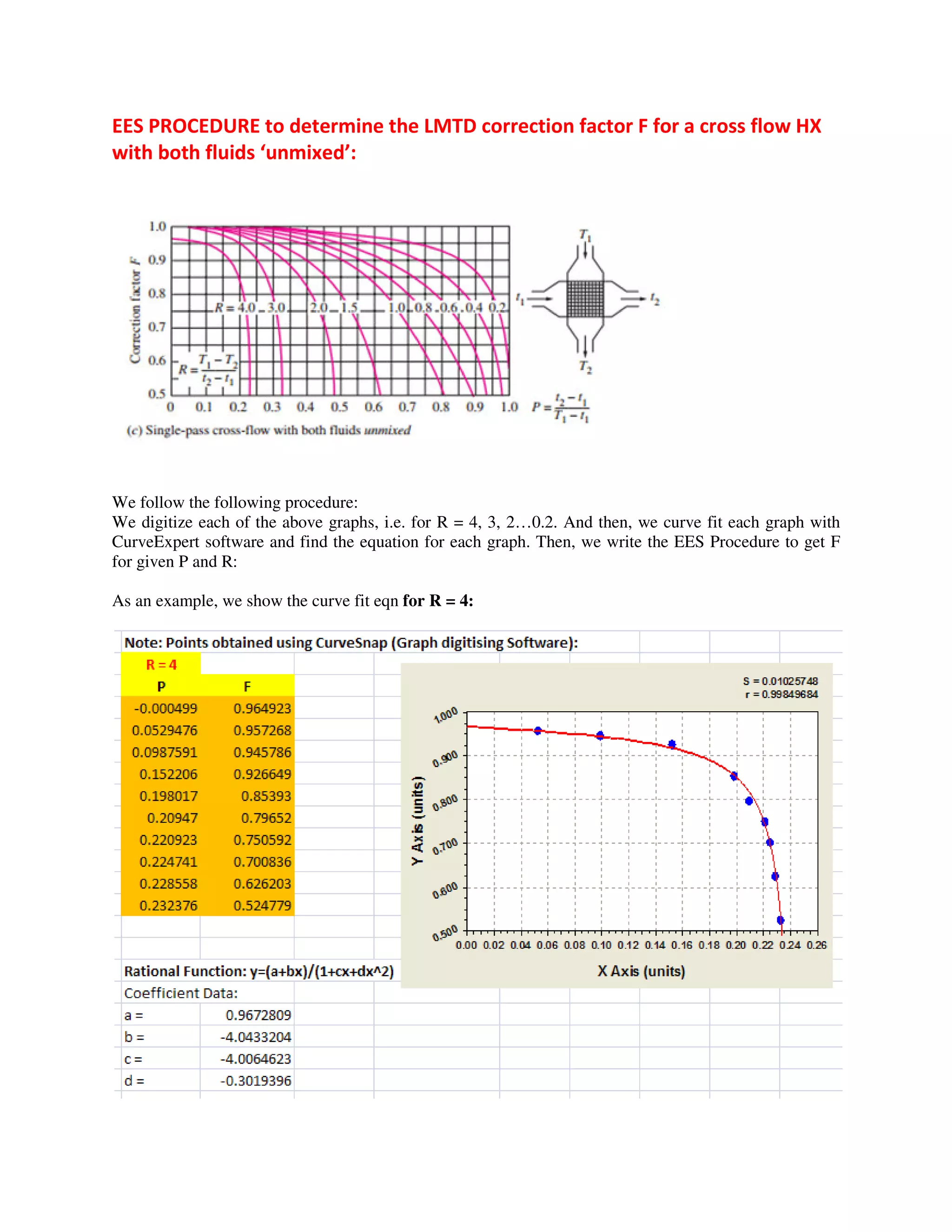

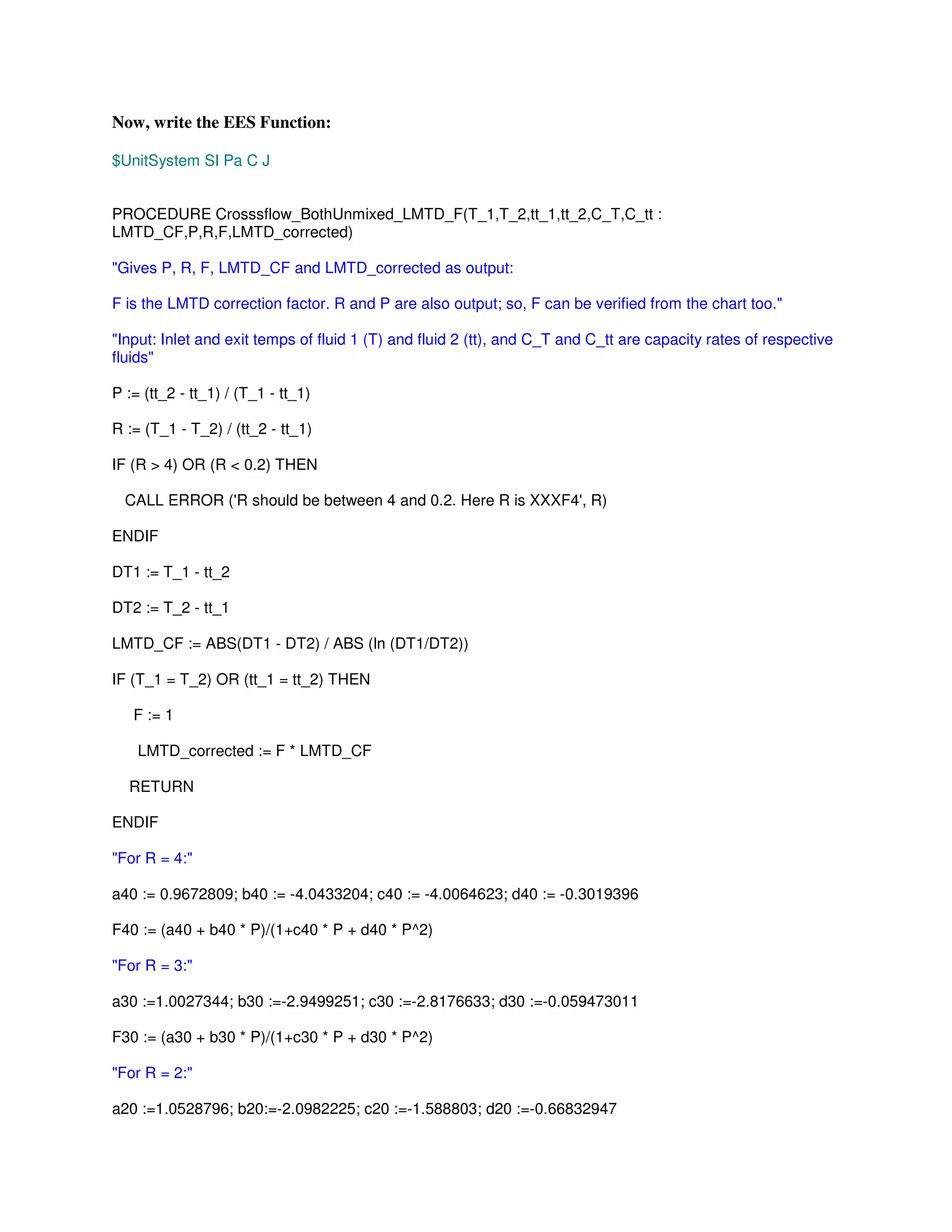
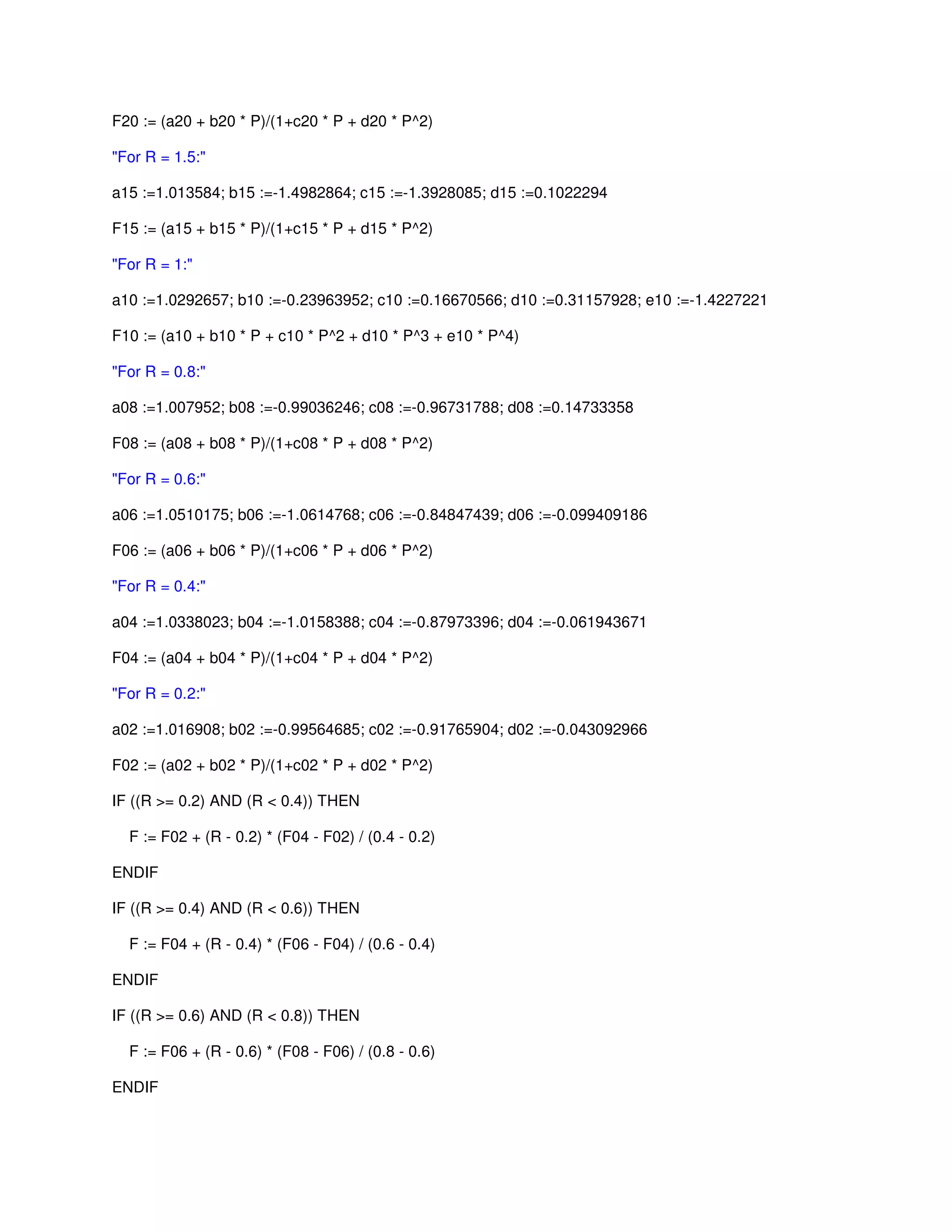
![IF ((R >= 0.8) AND (R < 1)) THEN
F := F08 + (R - 0.8) * (F10 - F08) / (1 - 0.8)
ENDIF
IF ((R >= 1) AND (R < 1.5)) THEN
F := F10 + (R - 1) * (F15 - F10) / (1.5 - 1)
ENDIF
IF ((R >= 1.5) AND (R < 2)) THEN
F := F15 + (R - 1.5) * (F20 - F15) / (2 - 1.5)
ENDIF
IF ((R >= 2) AND (R < 3)) THEN
F := F20 + (R - 2) * (F30 - F20) / (3 - 2)
ENDIF
IF ((R >= 3) AND (R <= 4)) THEN
F := F30 + (R - 3) * (F40 - F30) / (4 - 3)
ENDIF
LMTD_corrected := F * LMTD_CF
END
"============================================================="
"Prob. B.2.6. A cross-flow HX in which both fluids are un-mixed is used to heat water with engine oil.
Water enter at 30 C and leaves at 85 C at a rate of 1.5 kg/s, while the engine oil with cp = 2.3 kJ/kg.C
enters at 120 C with a mass flow rate of 3.5 kg/s. The heat transfer surface area is 30 m^2. Calculate the
overall heat transfer coefficient by using the LMTD method. [VTU -June - July 2009]"
Fig. Prob.B.2.6.
Now, we shall solve this problem using the EES Function written above:](https://image.slidesharecdn.com/eesfunctionsforheatexchangercalculations-161030143052/75/EES-Procedures-and-Functions-for-Heat-exchanger-calculations-33-2048.jpg)
![EES Solution:
"Data:"
m_h = 3.5 [kg/s] "...hot fluid---oil"
m_c = 1.5 [kg/s] "....cold fluid -- water"
T_h_i = 120 [C]
T_c_i = 30 [C]
T_c_o = 85 [C]
cp_h = 2300 [J/kg-C]
cp_c = 4180 [J/kg-C]
A = 30 [m^2]
m_h * cp_h * (T_h_i - T_h_o) = m_c * cp_c * (T_c_o - T_c_i) " C...determines T_h_o"
C_h = m_h * cp_h " W/C ... capacity ratre of hot fluid"
C_c = m_c * cp_c " W/C ... capacity ratre of cold fluid"
"To find LMTD Correction factor F for a cross-flow HX....
Either from the graph for a single pass HX with both fluids unmixed:, OR:
Use the EES Function written above"
CALL Crosssflow_BothUnmixed_LMTD_F(T_h_i,T_h_0,T_c_i,T_c_0,C_h,C_c :
LMTD_CF,P,R,F,LMTD_corrected)
Q = m_h * cp_h * (T_h_i - T_h_0) "W...heat tr."
Q = U * A * LMTD_corrected "... Finds U"
"=============================================="
{Note: F = 0.87 approx. " From graph given above, for values of R and P given below:"}
Results:
Thus:](https://image.slidesharecdn.com/eesfunctionsforheatexchangercalculations-161030143052/75/EES-Procedures-and-Functions-for-Heat-exchanger-calculations-34-2048.jpg)
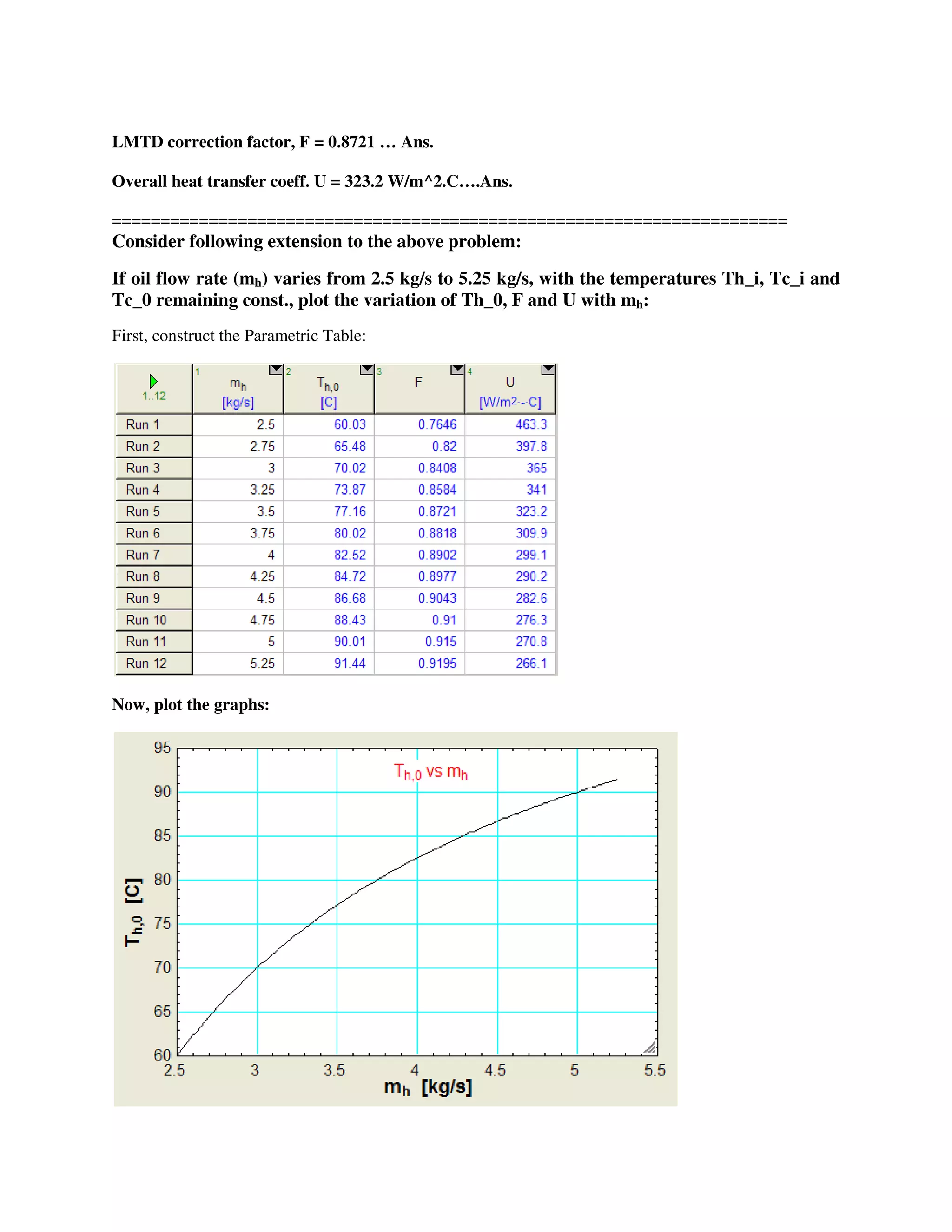

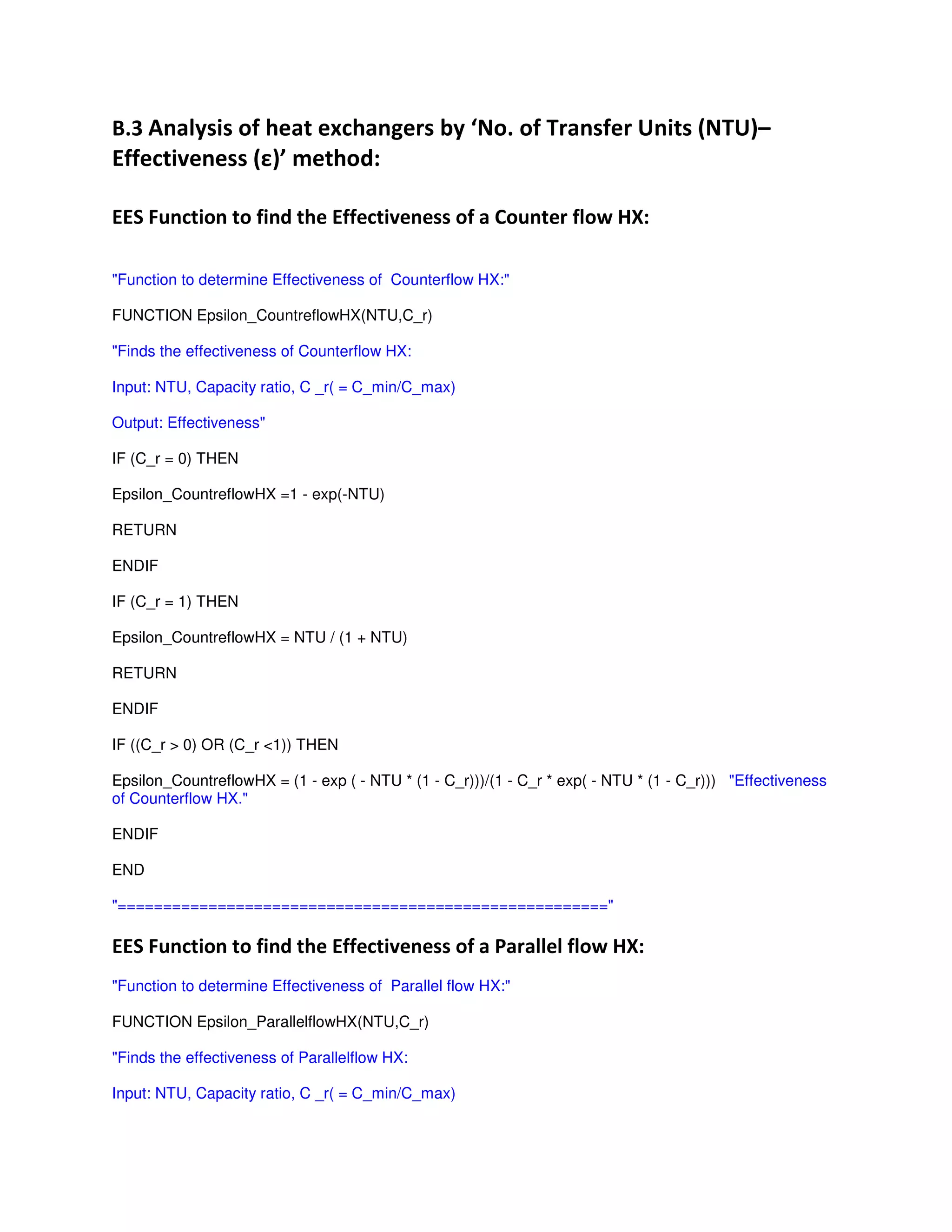
![Output: Effectiveness"
IF (C_r = 0) THEN
Epsilon_ParallelflowHX =1 - exp(-NTU)
RETURN
ENDIF
IF ((C_r > 0) OR (C_r <=1)) THEN
Epsilon_ParallelflowHX = (1 - exp ( - NTU * (1 + C_r)))/(1 + C_r) "Effectiveness of Parallelflow HX."
ENDIF
END
"======================================================"
"Prob. B.3.1. A water to water HX of a counter-flow arrangement has a heating surface area of 2 m^2.
Mass flow rates of hot and cold fluids are 2000 kg/h and 1500 kg/h respectively. Temperatures of hot and
cold fluids at inlet are 85 C and 25 C respectively. Determine the amount of heat transferred from hot to
cold water and their temps at the exit if the overall heat transfer coeff. U = 1400 W/m^2.K. [VTU -May -
June 2010]:
(b) Plot the variation of Q, Th_o and Tc_o as the mass flow rate of cold fluid, m_c varies from 0.1 to 0.5
kg/s. Assume other conditions to remain the same.”
Fig. Prob.B.3.1. Counter-flow arrangement
EES Solution:
"Data:"
m_h = 2000 [kg/h]* convert(kg/h, kg/s)
m_c = 1500 [kg/h] * convert(kg/h, kg/s)
T_h_i = 85 [C]](https://image.slidesharecdn.com/eesfunctionsforheatexchangercalculations-161030143052/75/EES-Procedures-and-Functions-for-Heat-exchanger-calculations-38-2048.jpg)
![T_c_i = 25 [C]
cp_h = 4180 [J/kg-C]
cp_c = 4180 [J/kg-C]
U = 1400 [W/m^2-C]
A = 2 [m^2]
"Calculations:"
C_h = m_h * cp_h "W/C...=2322"
C_c = m_c * cp_c "W/C... = 1742 "
C_min = C_c
C_max = C_h
C_r = C_min/C_max
NTU = U * A/C_min "...calculates NTU"
"For counterflow HX: Use the EES Function for Effectiveness of Counterflow HX, written above"
epsilon = Epsilon_CountreflowHX(NTU,C_r) "Effectiveness of Counterflow HX."
"Also:"
epsilon = (T_c_0 - T_c_i) / (T_h_i - T_c_i) "...by definition, taking the min fluid... calculates Tc_0"
Q = m_h * cp_h * (T_h_i - T_h_0) "W...heat tr... calculates Th_0"
Q= m_c * cp_c * (T_c_0 - T_c_i) "W... calculates Q"
"============================================================="
Results:
Thus:
Q = 69418 W, Th_0 = 55.11 C, Tc_0 = 64.86 C .. Ans.
-----------------------------------------------------------------------------------------------------
Plot the variation of Q, Th_o and Tc_o as the mass flow rate of cold fluid, m_c varies from
0.1 to 0.5 kg/s. Assume other conditions to remain the same:
First, compute the Parametric Table:](https://image.slidesharecdn.com/eesfunctionsforheatexchangercalculations-161030143052/75/EES-Procedures-and-Functions-for-Heat-exchanger-calculations-39-2048.jpg)
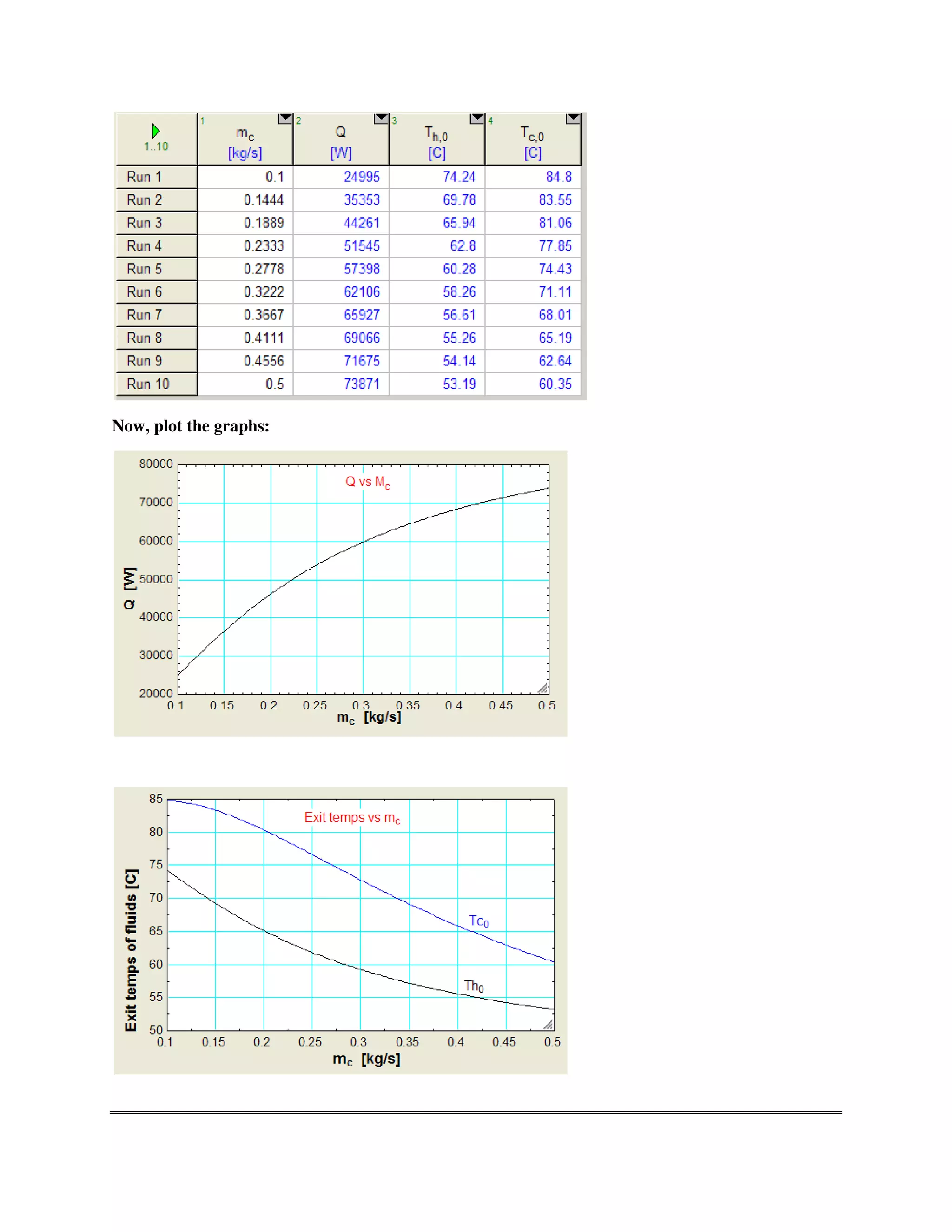
![“Prob. B.3.2. (M.U. 1995): Consider a heat exchanger for cooling oil which enters at 180 C, and cooling
water enters at 25 C. Mass flow rates of oil and water are: 2.5 and 1.2 kg/s, respectively. Area for heat
transfer = 16 m2. Sp. heat data for oil and water and overall U are given: Cpoil = 1900 J/kg.K; Cpwater =
4184 J/kg.K; U = 285 W/m2.K. Calculate outlet temperatures of oil and water for Parallel and counter-
flow HX.”
"
"Data:"
m_h = 2.5 [kg/s]
m_c = 1.2 [kg/s]
T_h_i = 180 [C]
T_c_i = 25 [C]
cp_h = 1900 [J/kg-C]
cp_c = 4184 [J/kg-C]
U = 285 [W/m^2-C]
A = 16 [m^2]
"Calculations:"
C_h = m_h * cp_h "W/C...=4750"
C_c = m_c * cp_c "W/C... = 5021 "
C_min = C_h
C_max = C_c
C_r = C_min/C_max
NTU = U * A/C_min "...calculates NTU"
"For Parallel flow HX: Using the EES Function for effectiveness:"
epsilon_pflow = Epsilon_ParallelflowHX(NTU,C_r) "...finds effectiveness of parallel flow HX"
"But, since hot fluid is 'minimum fluid', we have:"
epsilon_pflow = (T_h_i - T_h_0) / (T_h_i - T_c_i) "... finds T_h_0, exit temp of hot fluid"
Q = C_h * (T_h_i - T_h_0) "W ... heat transferred"
Q = C_c * (T_c_0 - T_c_i) "... finds T_c_0, exit temp of cold fluid"
Results for Parallel flow HX:](https://image.slidesharecdn.com/eesfunctionsforheatexchangercalculations-161030143052/75/EES-Procedures-and-Functions-for-Heat-exchanger-calculations-41-2048.jpg)
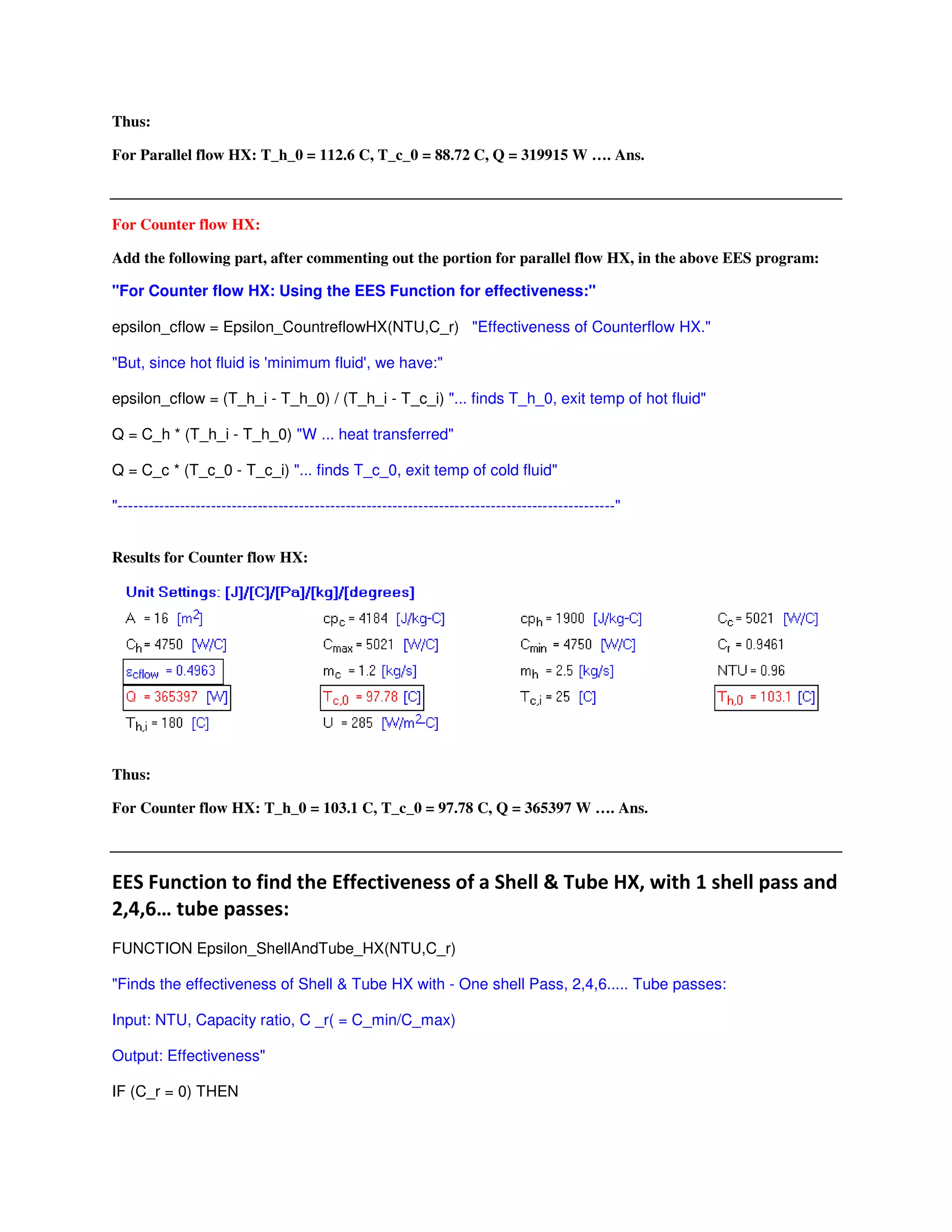
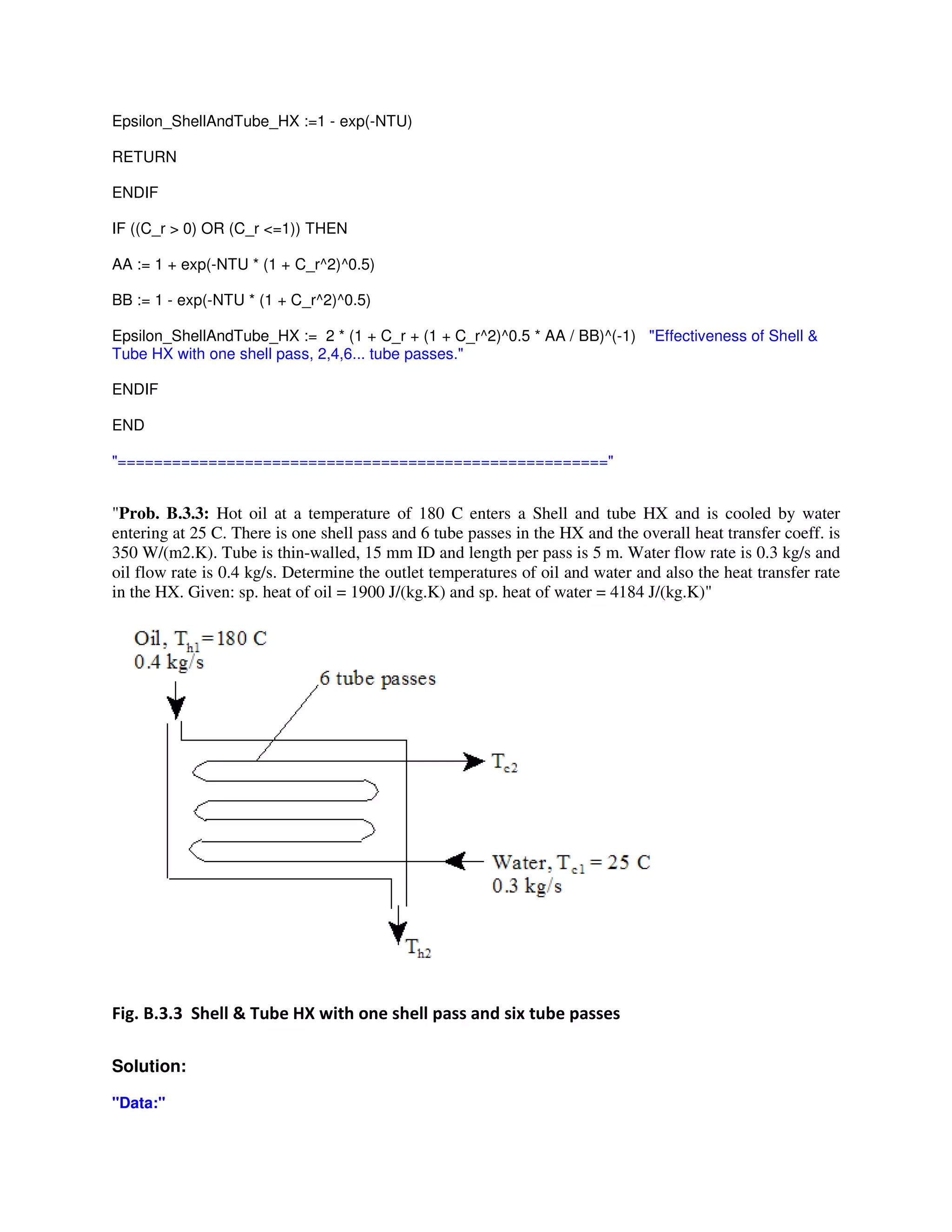
![m_h = 0.4 [kg/s]
m_c = 0.3 [kg/s]
Th_1 = 180 [C]
Tc_1 = 25 [C]
U = 350 [W/m^2 - C]
D = 0.015 [m] "..ID of tubes"
L = 5 [m] "...length per pass"
cp_h = 1900 [J/kg-C]
cp_c = 4184 [J/kg-C]
n = 6 "...no. of tube passes"
"Calculations:"
C_h = m_h * cp_h " W/C ... capacity rate of hot fluid = 760 W/C"
C_c = m_c * cp_c " W/C ... capacity rate of cold fluid = 1255 W/C "
"Therefore: hot fluid is the 'minimum fluid"
C_min = C_h
C_max = C_c
C_r = C_min / C_max "... capacity ratio"
"Total heat transfer area, A:"
A = n * pi * D * L "m^2... n = 6. no. of tube passes"
NTU = U * A / C_min "... calculates NTU"
"Knowing NTU and C_r, calculate effectiveness ... Use the EES Function written above:"
epsilon = Epsilon_ShellAndTube_HX(NTU,C_r) ".... calculates effectiveness"
Q_max = C_min * (Th_1 - Tc_1) " W ... max possible heat transfer"
Q_actual = epsilon * Q_max " W... actual heat transfer in the HX"
"Outlet temps of fluids:"
Q_actual = C_h * (Th_1 - Th_2) "... calculates outlet temp of hot fluid, Th_2 (deg.C)"
Q_actual = C_c * (Tc_2 - Tc_1) "... calculates outlet temp of cold fluid, Tc_2 (deg.C)"](https://image.slidesharecdn.com/eesfunctionsforheatexchangercalculations-161030143052/75/EES-Procedures-and-Functions-for-Heat-exchanger-calculations-44-2048.jpg)
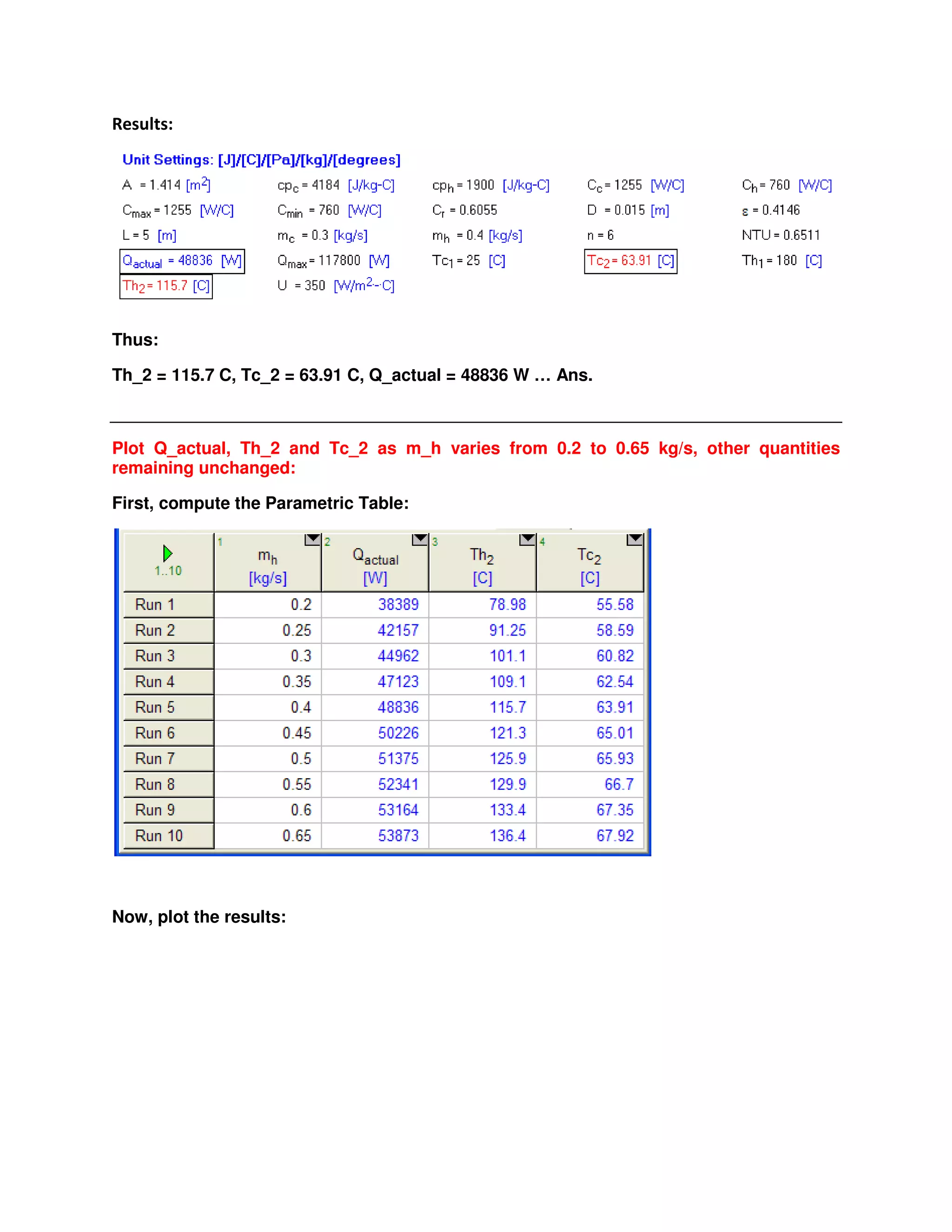
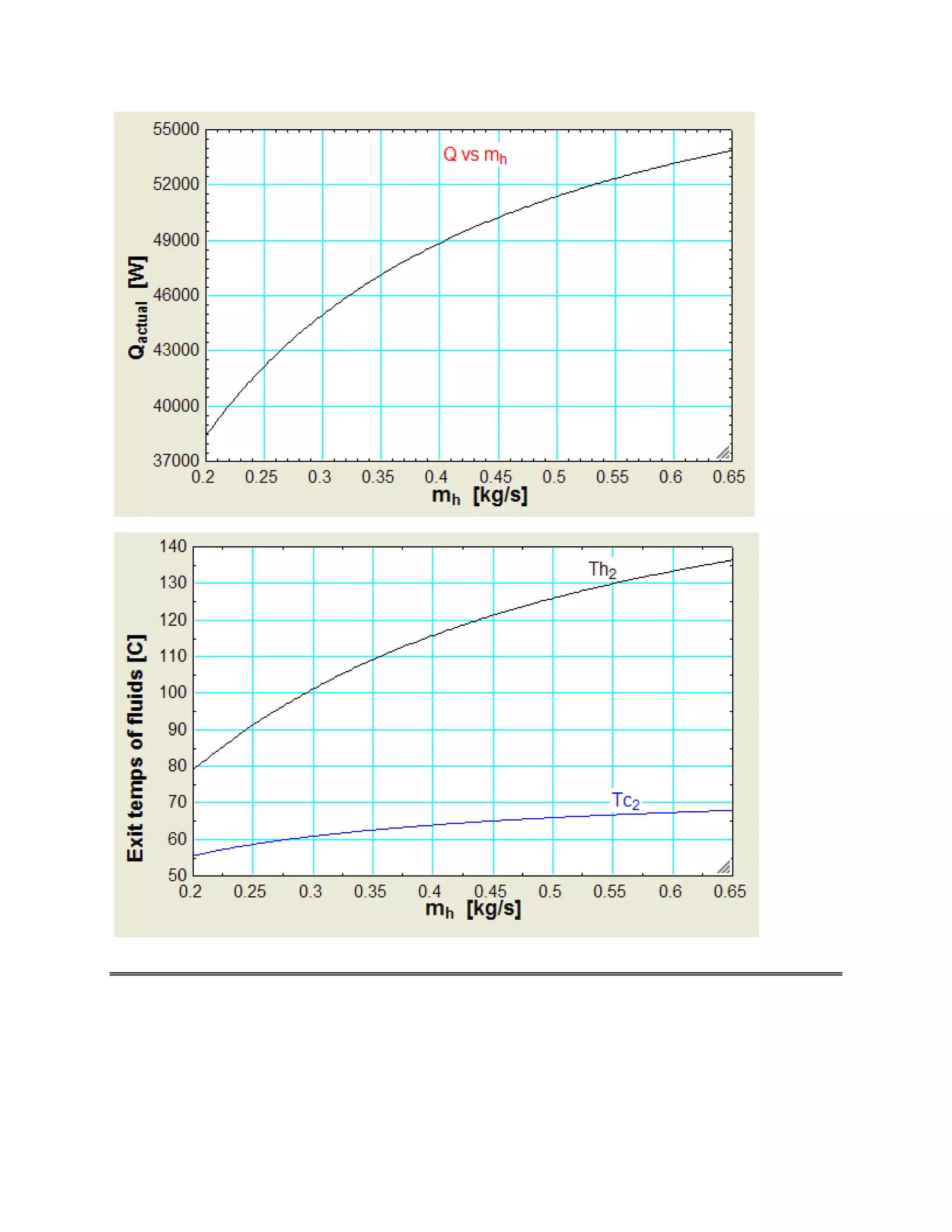
![# 5 L, #
M #N"
"Function to determine Effectiveness of Crossflow HX with both fluids Unmixed:"
FUNCTION Epsilon_Crossflow_bothUnmixed(NTU,C_r)
"Finds the effectiveness of Crossflow HX with both fluids Unmixed:
Input: NTU, Capacity ratio, C _r( = C_min/C_max)
Output: Effectiveness"
IF (C_r = 0) THEN
Epsilon_Crossflow_bothUnmixed :=1 - exp(-NTU)
RETURN
ENDIF
IF ((C_r > 0) OR (C_r <=1)) THEN
Epsilon_Crossflow_bothUnmixed := 1 - exp ( (1/C_r) * NTU^0.22 * ( exp( - C_r * NTU^0.78) - 1))
"Effectiveness of Cross-flow HX ..Ref: Incropera. "
ENDIF
END
"======================================================"
Now, solve a problem using the above EES Function:
"Prob.B.3.4. A cross-flow HX (both fluids unmixed), having a heat transfer area of 8.4 m^2, is to heat air
(cp = 1005 J/kg.K) with water (cp = 4180 J/kg.K). Air enters at 18 C with a mass flow rate of 2 kg/s while
water enters at 90 C with a mass flow rate of 0.25 kg/s. Overall heat transfer coeff is 250 W/m^2.K
Calculate the exit temps of the two fluids and the heat transfer rate. [VTU - July-Aug. 2004]"
(b) Plot the variation of Q and Th_o and Tc_o as air flow rate, m_c varies from 1.5 to 3 kg/s, all other
conditions remaining the same as earlier:
Fig. Prob.B.3.4. Cross-flow arrangement](https://image.slidesharecdn.com/eesfunctionsforheatexchangercalculations-161030143052/75/EES-Procedures-and-Functions-for-Heat-exchanger-calculations-47-2048.jpg)
![EES Solution:
"Data:"
m_h = 0.25 [kg/s] "....water is the hot fluid"
m_c = 2[kg/s] "....air is the cold fluid"
T_h_i = 90 [C]
T_c_i = 18 [C]
cp_c = 1005 [J/kg-C]
cp_h = 4180 [J/kg-C]
U = 250 [W/m^2-C]
A = 8.4 [m^2]
Calculations:
C_h = m_h * cp_h "W/C...= 1045 … capacity rate of hot fluid"
C_c = m_c * cp_c "W/C... = 2010 … capacity rate of cold fluid"
C_min = C_h “….min. capacity rate”
C_max = C_c ”…max. capacity rate”
C_r = C_min/C_max “… Capacity ratio”
NTU = U * A /C_min “…NTU by definition”
"For cross-flow HX: Using the EES Function for effectiveness of Cross flow HX, with both fluids Unmixed,
written earlier:"
epsilon = Epsilon_Crossflow_bothUnmixed(NTU,C_r) "Effectiveness of Cross-flow HX ..Ref: Incropera. "
"Also:"
epsilon = (T_h_i - T_h_o)/(T_h_i - T_c_i) "...determines exit temp of hot fluid, i.e. water, T_h_o"
Q= m_h * cp_h * (T_h_i - T_h_o) "W ... determines Q"
Q = m_c * cp_c * (T_c_o - T_c_i) "W...determines exit temp of cold fluid, i.e. air, T_c_o."
"====================================================================="
Results:
Thus:
Q = 55286 W … heat transferred … Ans.
Th_0 = 37.09 C … exit temp of hot fluid (water) …. Ans.](https://image.slidesharecdn.com/eesfunctionsforheatexchangercalculations-161030143052/75/EES-Procedures-and-Functions-for-Heat-exchanger-calculations-48-2048.jpg)
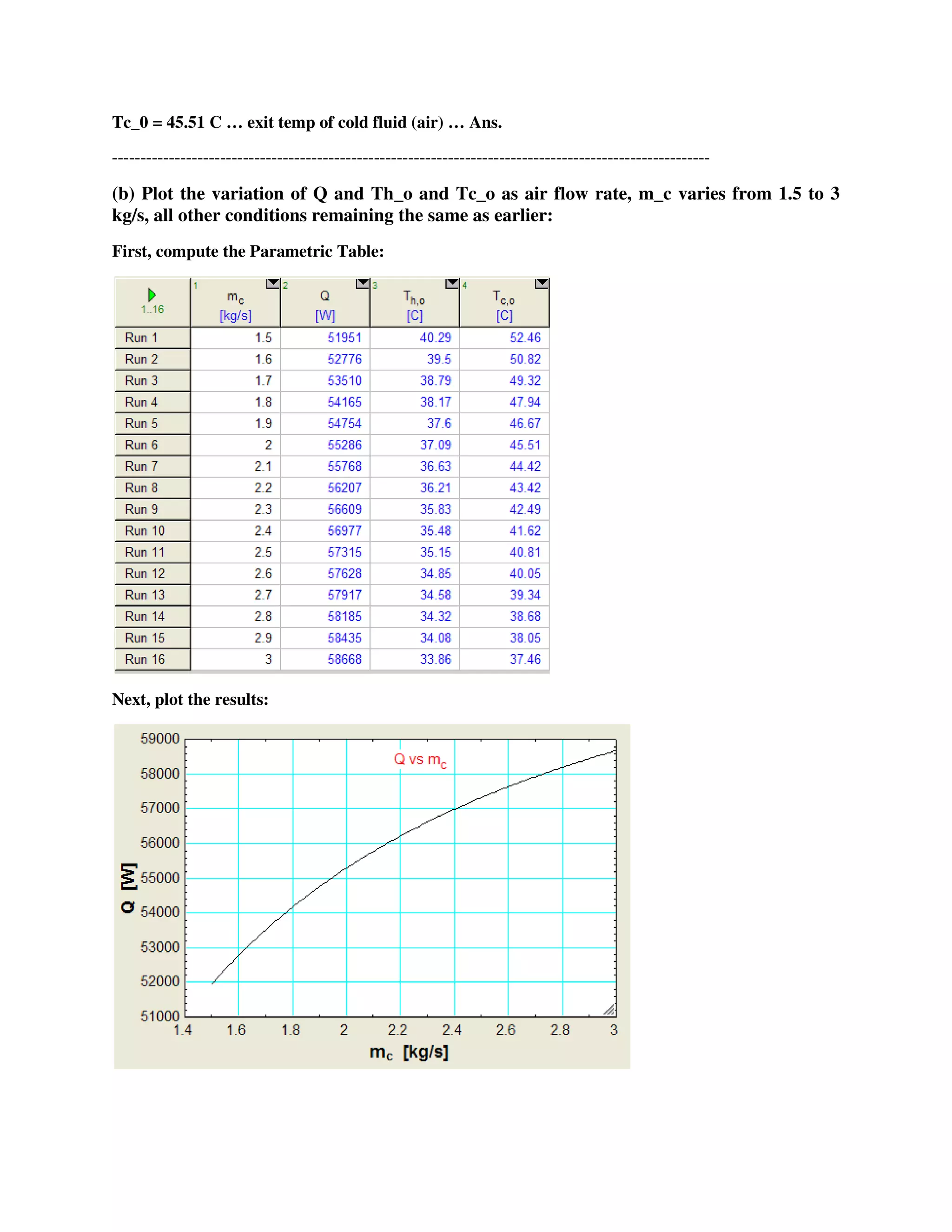

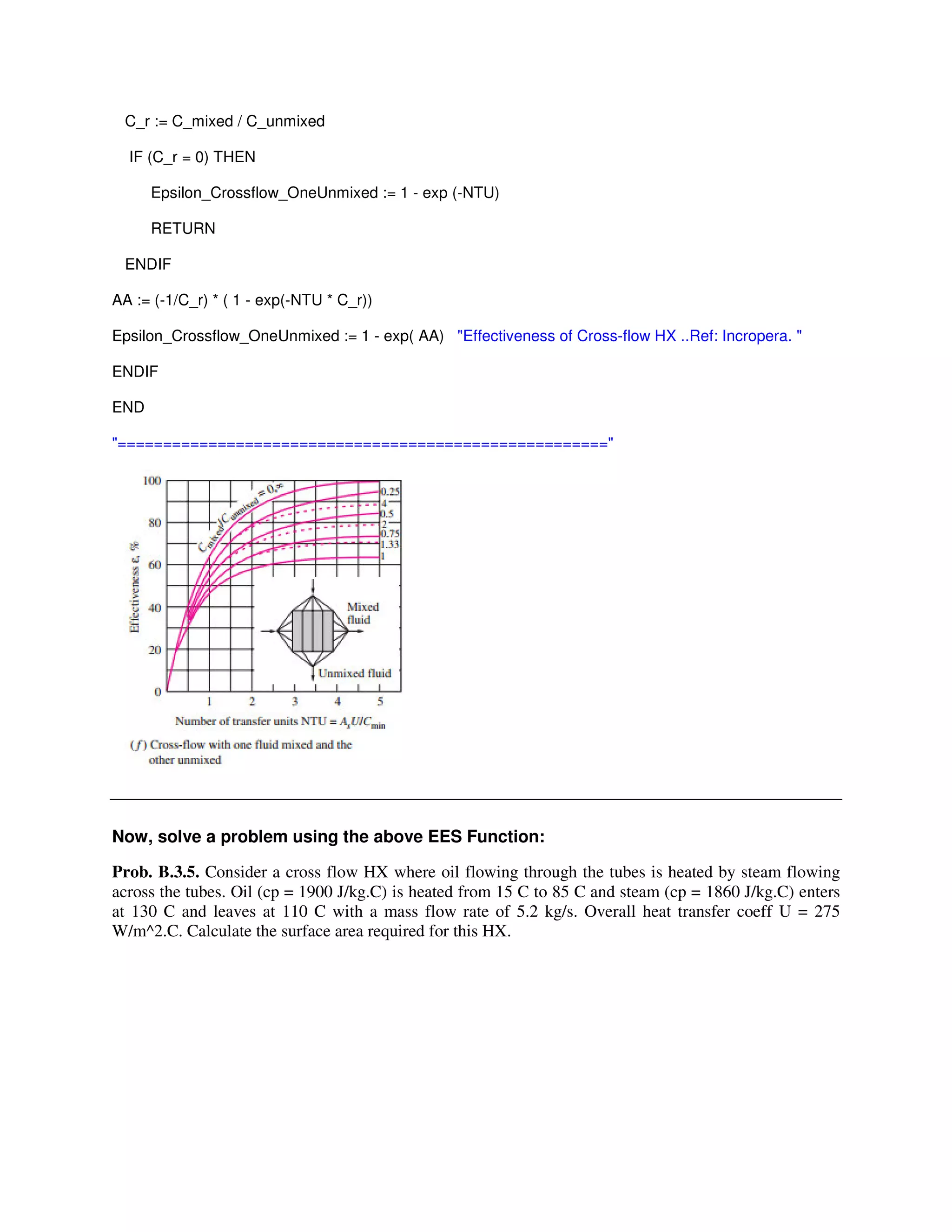
![EES Solution:
"Data:"
"Steam is the 'mixed' fluid and oil is the 'un-mixed' fluid."
m_h = 5.2 [kg/s] "....steam is the hot fluid, 'mixed' fluid"
T_h_i = 130 [C]
T_c_i = 15 [C]
T_c_0 = 85 [C]
T_h_0 = 110 [C]
cp_c = 1900 [J/kg-C]
cp_h = 1860 [J/kg-C]
U = 275 [W/m^2-C]
"Calculations:"
C_mixed = m_h * cp_h "W/C...= 9672 capacity rate of hot fluid"
Q = C_mixed * (T_h_i - T_h_0) "W ... heat transfer in HX"
Q = C_unmixed * (T_c_0 - T_c_i) "...finds C_unmixed, ... 2763 [W/C]"
C_unmixed = m_c * cp_c "...finds m_c, flow rate of cold fluid (oil), kg/s"
"Since we find that oil is the minimum fluid, we can write for Effectiveness:"
epsilon = (T_c_0 - T_c_i) / (T_h_i - T_c_i) "... effectivenes, by definition"
"Then, to find NTU: Use the EES Function written above for Effectiveness of this HX.
Note that when effectiveness and Capacity rates are known, the same Function determines the
other unknown, viz. NTU:"
epsilon = Epsilon_Crossflow_OneUnmixed(NTU,C_mixed, C_unmixed) "Effectiveness of Cross-flow HX
.....finds NTU "
"Also, since oil is the 'minimum' fluid:"
NTU = U * A / C_unmixed "...finds A [m^2]"
"====================================================================="](https://image.slidesharecdn.com/eesfunctionsforheatexchangercalculations-161030143052/75/EES-Procedures-and-Functions-for-Heat-exchanger-calculations-52-2048.jpg)
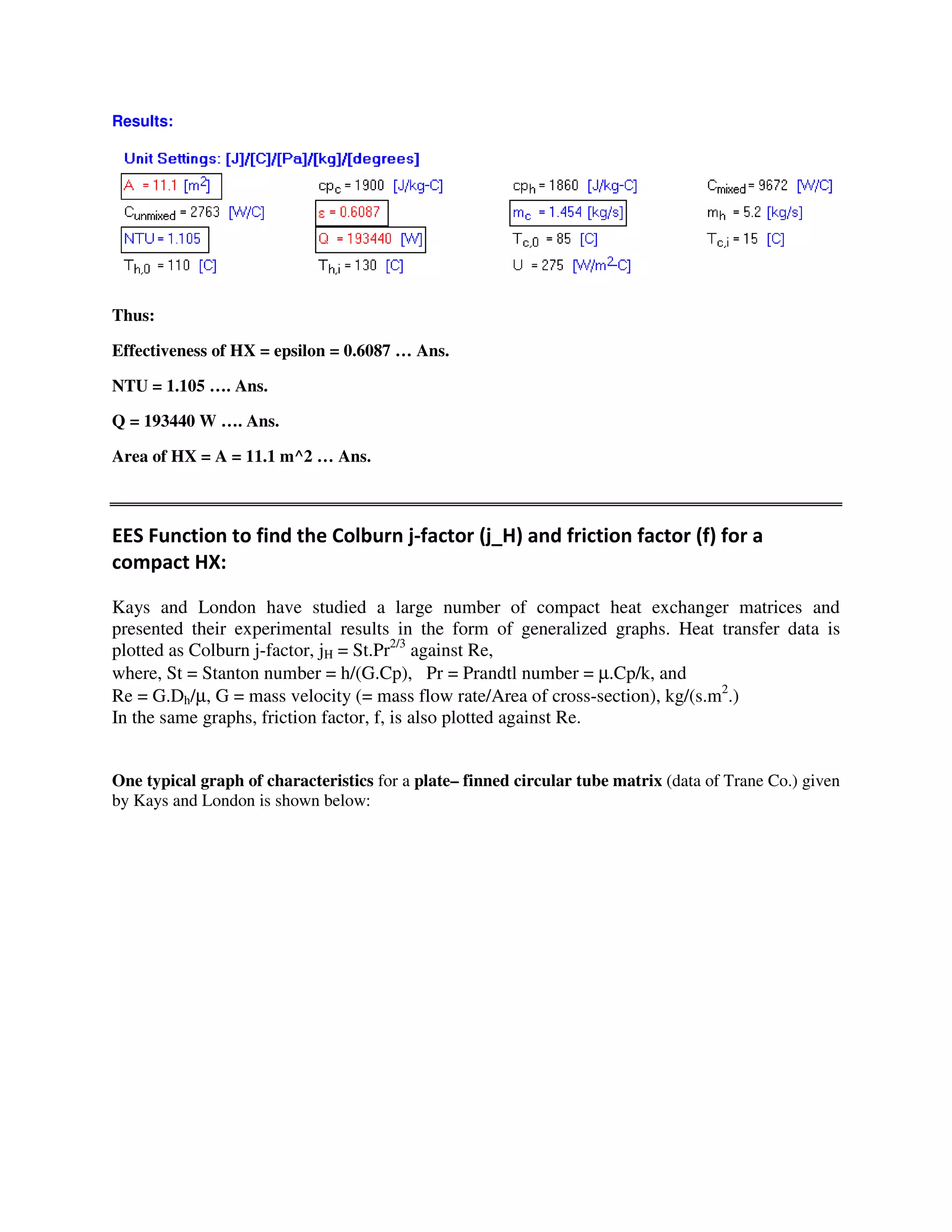
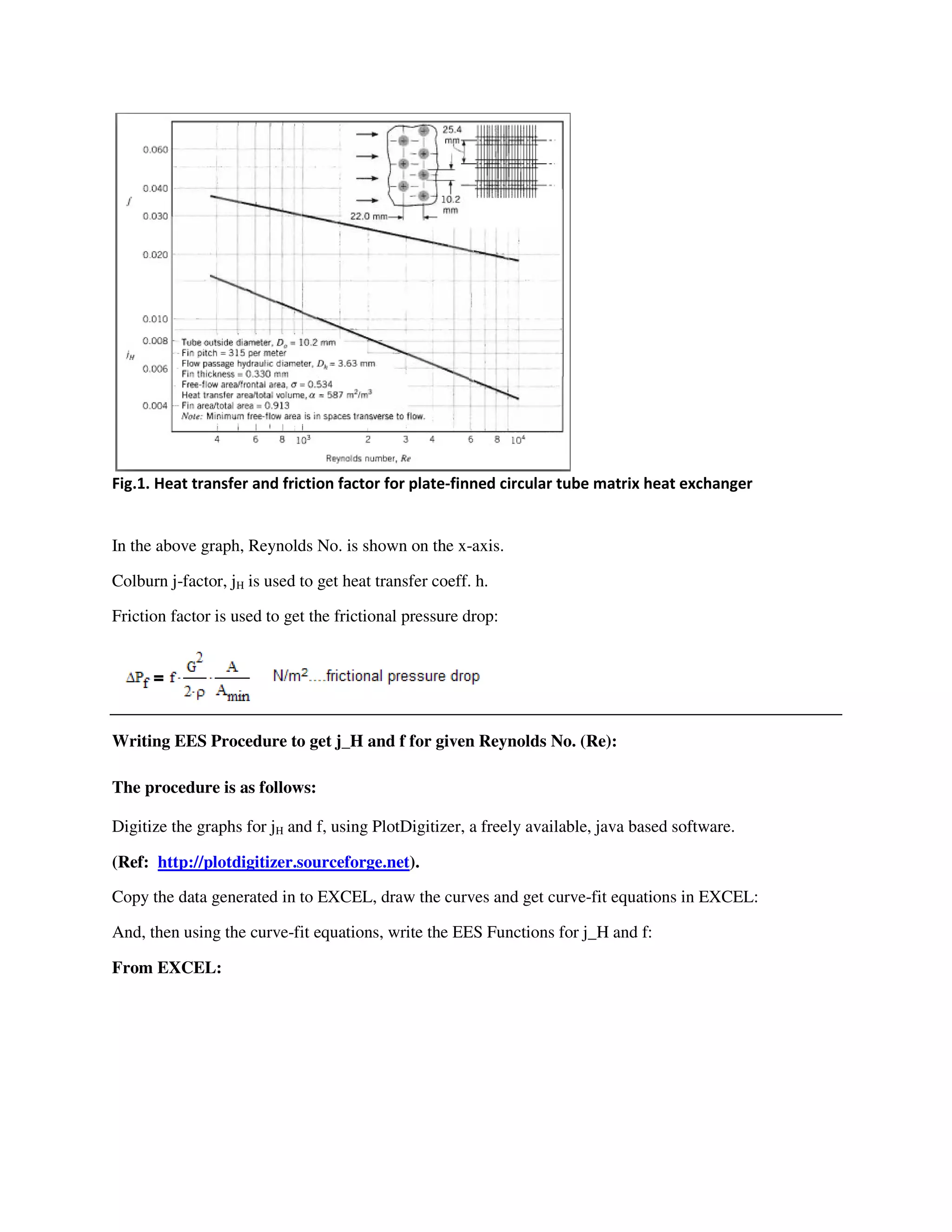
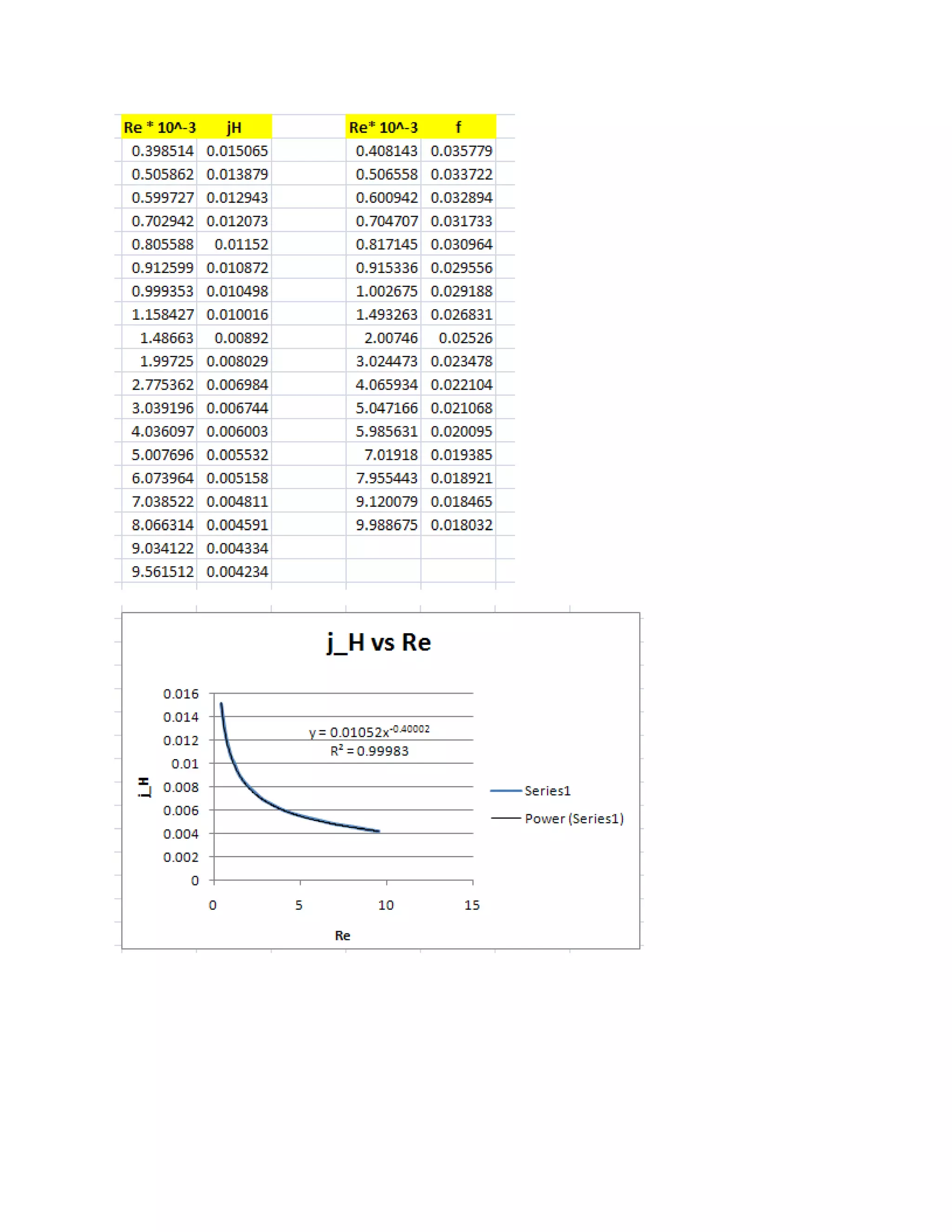
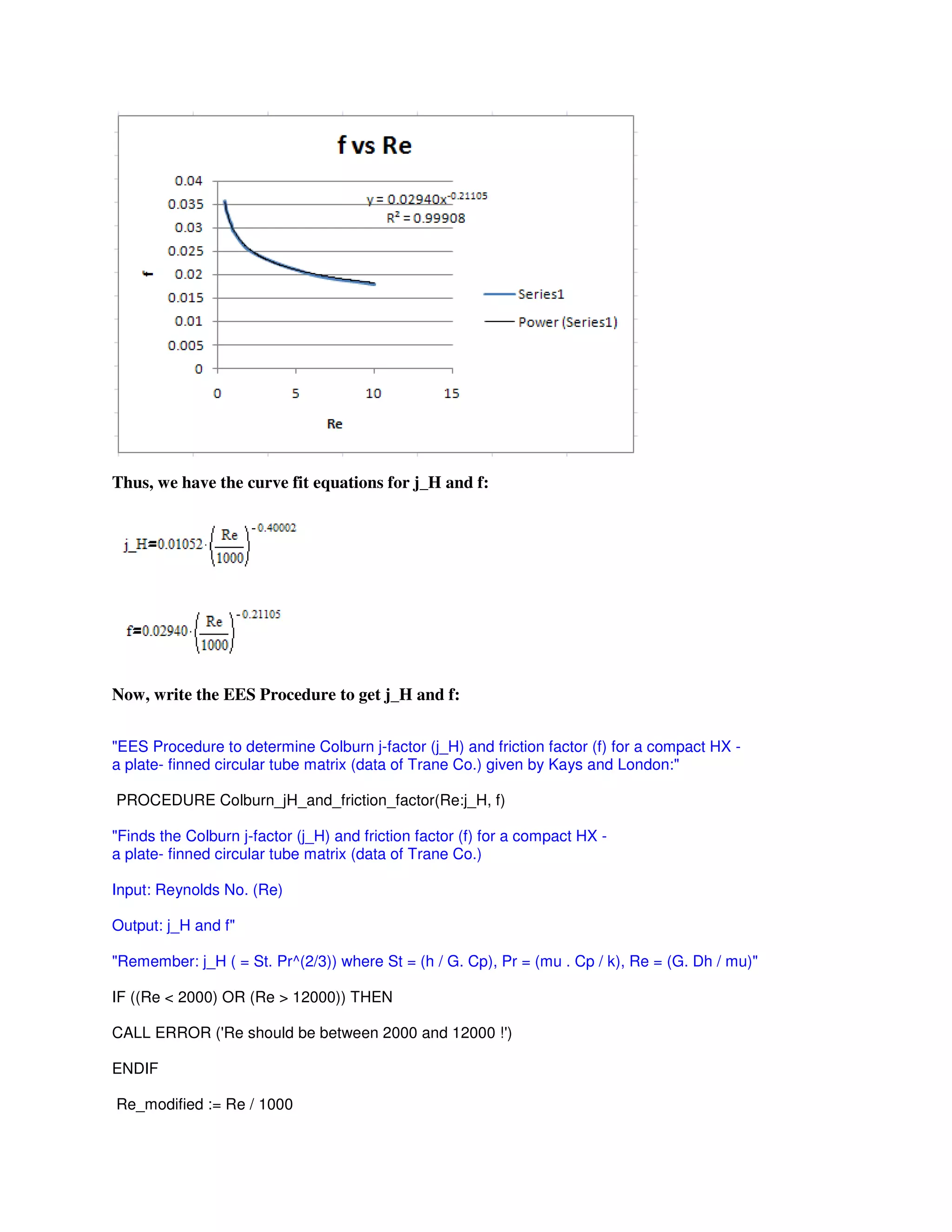
![j_H := 0.01052 * (Re_modified)^(-0.40002)
f := 0.02940 * (Re_modified)^(-0.21105)
END
"======================================================"
Now, let us solve a problem on compact heat exchangers:
Prob. B.3.6: Air at 2 atm and 400 K flows at a rate of 5 kg/s, across a finned circular tube matrix, for
which heat transfer and friction factor characteristics are shown in Fig.1 above. Dimensions of the heat
exchanger matrix are: 1 m (W) x 0.6 m (Deep) x 0.5 m (H), as shown in Fig.below. Find: (a) the heat
transfer coeff. (b) the friction factor, and (c) ratio of core friction pressure drop to the inlet pressure.
EES Solution:
"Data:"
m = 5 [kg/s]
A_fr = 0.5 [m^2] "...frontal area"
L = 0.6 [m] "...length of flow"
P_air = 2 * 101.3 * 10^3 [Pa]
T_air = 400 - 273 "[C]"
"Properties of Air at 2 atm and 400 K:"
rho = Density(Air,T=T_air,P=P_air) "[kg/m^3]"
mu = Viscosity(Air,T=T_air)" Dyn. viscosity, kg/m.s"
cp = SpecHeat(Air,T=T_air) "sp. heat, J/kg.C"
Pr = Prandtl(Air,T=T_air) "Prandtl No."](https://image.slidesharecdn.com/eesfunctionsforheatexchangercalculations-161030143052/75/EES-Procedures-and-Functions-for-Heat-exchanger-calculations-57-2048.jpg)
!["From the Fig.1, i.e. Heat transfer and friction factor characteristics for plate-finned circular tube matrix
heat exchanger, we have:"
sigma = 0.534 ; D_h = 3.63E-03 "m .... hydraulic dia"
sigma = A_min / A_fr " .. by definition"
"Mass velocity: G:"
G = m / A_min " .... mass velocity, [kg/s-m^2]"
"Reynolds No.:"
Re = G * D_h / mu "...Reynolds No."
"We get Re = 2965. Now, use the EES Procedure written above to get j_H and f:"
CALL Colburn_jH_and_friction_factor(Re:j_H, f)
"But, we have:"
j_H = St * Pr^(2/3) "... Colburn j-factor"
St = h /(G * cp)"... Stanton No... h = heat tr coeff. .... finds h"
"Pressure drop:"
" DELTAP_f = f * (G^2 / (2 * rho)) * (A / A_min)
And, (A / A_min) = 4 * L / D_h . Therefore:"
DELTAP_f = f * (G^2 / (2 * rho)) * (4 * L / D_h ) " Pressure drop, N/m^2"
PressureDrop_fraction =( DELTAP_f / P_air) *100 " % . of inlet pressure"
"================================================================"
Results:](https://image.slidesharecdn.com/eesfunctionsforheatexchangercalculations-161030143052/75/EES-Procedures-and-Functions-for-Heat-exchanger-calculations-58-2048.jpg)
